Personal construct psychology methods for qualitative research
心理学专业英文词汇【I】
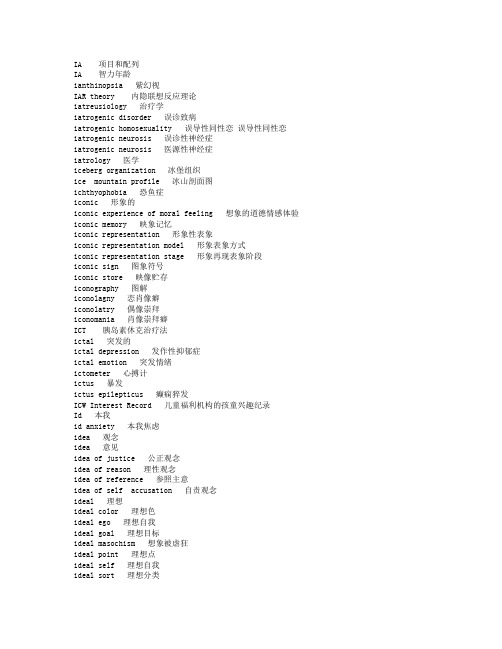
IA 项目和配列IA 智力年龄ianthinopsia 紫幻视IAR theory 内隐联想反应理论iatreusiology 治疗学iatrogenic disorder 误诊致病iatrogenic homosexuality 误导性同性恋误导性同性恋iatrogenic neurosis 误诊性神经症iatrogenic neurosis 医源性神经症iatrology 医学iceberg organization 冰堡组织ice mountain profile 冰山剖面图ichthyophobia 恐鱼症iconic 形象的iconic experience of moral feeling 想象的道德情感体验iconic memory 映象记忆iconic representation 形象性表象iconic representation model 形象表象方式iconic representation stage 形象再现表象阶段iconic sign 图象符号iconic store 映像贮存iconography 图解iconolagny 恋肖像癖iconolatry 偶像崇拜iconomania 肖像崇拜癖ICT 胰岛素休克治疗法ictal 突发的ictal depression 发作性抑郁症ictal emotion 突发情绪ictometer 心搏计ictus 暴发ictus epilepticus 癫痫猝发ICW Interest Record 儿童福利机构的孩童兴趣纪录Id 本我id anxiety 本我焦虑idea 观念idea 意见idea of justice 公正观念idea of reason 理性观念idea of reference 参照主意idea of self accusation 自责观念ideal 理想ideal color 理想色ideal ego 理想自我ideal goal 理想目标ideal masochism 想象被虐狂ideal point 理想点ideal self 理想自我ideal sort 理想分类ideal strategy 理想策略ideal type 理想型ideal world 理想世界idealism 理想主义idealism 唯心论idealist apriorism 唯心论的先验观idealistic positivism 唯心实证主义idealistic psychology 唯心主义心理学唯心主义心理学ideality 理想idealization 理想化idealized image 理想化形象idealized self 理想化我idealless 没理想的ideate 形成概念ideation 观念作用ideational apraxia 观念性失用症ideational learning 观念学习ideational memory 观念记忆ideational type 观念型idea chase 意念飘忽idea motor 意念运动identical 相同的identical anchor items 相同参照测验题相同定锚测验题identical concept 同一概念identical element 相同要素identical elements theory 同元素论identical retinal point 网膜对应点identical twins 同卵双生identifiability principle 辨识原则identifiability principle 同一性原则identification 认同identification 识别identification ability 识别能力identification code 识别码identification condition 识别条件identification figure 认同人物identification foreclosure 同一性拒斥identification learning 辨别学习identification marking 识别标志identification of evidence 证据辨认identification problem 识别问题identification test 鉴别测验identification time 辨别时间identifier 识别符identify 识别identifying restrictions 识别的约束条件识别的约束条件identity 认同identity achievement 认同达成identity crises 认同危机identity diffusion 认同性扩散identity diffusion syndrome 同一性扩散综合症identity foreclosure 过早自认identity foreclosure 早闭型统合identity formation 自认形成identity hypothesis 同一性假说identity level of concept 概念守恒阶段概念守 阶段identity moratorium 未定型统合identity moratorium 自认拖延identity of object and self 物我合一identity of perception 知觉同一性identity of relation 关系的同一identity of thinking and being 思维和存在的同一性identity test 鉴定试验identity vs role diffusion 同一性与角色混乱identity vs role diffusion conflict 自认与角色扩散之矛盾ideodynamism 观念统制ideogenetic 观念性的ideoglandular 观念性腺分泌ideogram 表意文字ideograph 符号ideography 意符系统ideokinetic 意念性动作的ideokinetic apraxia 意想运动性运用不能ideolectotype 自选模式标本ideological 意识形态的ideological education 意识形态教育ideological form 观念形态ideologue 空想家ideology 意识形态ideometabolism 观念性代谢ideomotion 观念性动作ideomotor 意识运动性的ideophobia 观念恐怖症ideophone 摹拟音ideophrenia 观念倒错ideoplasy 观念凝注ideoreflex 观念反射ideo motion training 念动训练ideo motor 念动ideo motor apraxia 观念 运动性失用症观念 运动性失用症ideo motor theory 动念说idioadaptation 特殊适应idioadaptation evolution 特殊适应性演化idiochromosome 性染色体idiocrasy 特异反应性idioctonia 自杀idiocy 白痴idioecology 个体生态学idiogamist 自偶者idiogenesis 自发病idioglossia 新语病idiographic 个人签名的idiographic approach 个人特质研究法个人特质研究法idiographic psychology 特殊规律心理学特殊规律心理学idiohypnotism 自我催眠idiolalia 自语症idiolect 个人言语特点idiologism 自解言语症idiom 成语idiom 惯用语idioneural 神经自身的idiopathia 自发病idiopathic 自发idiopathic epilepsy 自发性癫痫症idiophrenic 脑本身的idioplasm 胚质idiopsychologic 自发心理的idioreflex 自发性反射idiosyncrasy 特异反应性idiosyncrasy 特质idiosyncrasy credit 特殊信任idiot 白痴idiot 低能idiotia 白痴idiotia diplegica 双侧瘫性白痴idiotia epileptica 癫痫性白痴idiotia familialis amaurotica 黑蒙家族性白痴idiotia hemiplegica 偏瘫性白痴idiotia hydrocephalica 水脑性白痴idiotia microcephalica 小头性白痴idiotia paralytica 麻痹性白痴idiotia paraplegica 截瘫性白痴idiotic 白痴的idiotropic 内省的idiotype 个体基因型idiot savant 低能特才idiovariation 自发性变异idio imbecile 痴愚idol 偶像idolater 偶像崇拜者idolatress 偶像崇拜者idolatrous 崇拜偶像的idolatry 偶像崇拜idolum 谬论id ego conflict 伊特 自我冲突IE 工业工程工业工程IE ratio 呼吸比率ignominy 耻辱ignoramus 毫无知识的人ignorance 愚昧ignore 不顾ikonic 形象的illation 演绎illegal demand 非法需要illegal mind 违法心理illegality 违法illegitimacy 不合理illegitimate children 私生儿童illegitimate combination 不正常结合illegitimate copulation 不正常接合illegitimate political behavior 非法的政治行为illiberal 无教养的illicit 不正当的Illinois Test of Psycholinguistic Abilities 伊利诺心理语言能力测验illiteracy 文盲illness 疾病illness frequency rate 患病率illness management 管理不善illness suited 不适合illuminance 照度illuminant color 发光色illumination 豁朗期illumination 照明illumination distribution 照明分布illumination effect 照明效应illumination ergonomics 照明工效学illumination flicker 照度闪耀illumination level 照明水平illumination meter 照度计illumination theory of cognition 光照论illumination uniformity 照明均匀性illumine 启发illusion 错觉illusion in flight 飞行错觉illusion of angle and direction 角度 方向错觉illusion of assimilation contrast of concentric circles 同心圆同化 对比错觉illusion of auditory 听错觉illusion of control 控制错觉illusion of curvature 弯曲错觉illusion of doubles 相联错觉illusion of false recognition 误认错觉illusion of memory 记忆错觉illusion of movement 运动错觉illusion of negative doubles 反向相识错觉illusion of orientation 定向错觉illusion of positive doubles 正向相识错觉illusion of size 大小错觉illusion of unanimity 一致性错觉illusory contour 错觉轮廓illustration 说明illutation 泥浴疗法ill being 不好的境地ill breeding 教养不好ill defined problem 定义有缺陷问题定义有缺陷问题ill feeling 敌意ill fortune 厄运ill humour 心情恶劣image 映象image analysis 映象分析image formation 成象image interview 映象面谈image memory 表象记忆image of problem 问题表象image processing 想象过程image scanning 意象审视image strategy 意象战略image survey 意象调查image training 表象训练image type 表象型imageless thinking 无意象思维imageless thought 无意象思考imagery 意象imagery code 意象码imagery therapy 想象治疗法imagery thinking 意象思维imagery training 意象训练imagery type 意象型imaginal memory 形象记忆imaginal thinking 形象思维imaginary audience 假想观众imaginary audience in adolescence 青少年期的假想观众imaginary color stimulus 假想色刺激imaginary companion 假想游伴imaginary playmates 假想玩伴imaginary space 想象空间imaginary threshold 假想临界imagination 想象imagination in music 音乐想象imagination training 想象训练imaginative 富于想象的imaginative image 想象表象imaginative play 想象游戏imaginative power 想象力imagine 想象imago 潜存替象imago 无意识意向imbalance 不平衡imbalantia 肌平衡觉缺失imbecile 痴愚imbecility 愚笨imbecillitas 痴愚imbecillitas phenylpyruvica 智力发育不全性苯丙酮尿imbedding 嵌入imbedding method 嵌入法imbroglio 纠葛imipramine 丙咪嗪imitate 模拟imitated tactic training 战术模拟训练imitation 模仿imitation law 模仿律imitation learning 模仿学习imitation of sex typed behavior 性别行为的模仿imitation psychology 模仿心理学imitation strategy 模仿战略imitation theory of crime 犯罪模仿论犯罪模 论imitation with expansion 扩充模仿imitative imagination 模仿想象imitative learning 模仿学习imitative play 模仿性游戏imitative sound 模仿音imitativeness 模仿性imitator 模拟器immanence 内在性immanent 内在的immanent action 内在活动immanent contradiction 内在矛盾immanent factor 内在因素immaterial 非物质的immaterial substance 非物质实体immature 不成熟immature 未成熟的immature personality 幼稚人格immatureness 未成熟immaturity 不成熟immaturity of emotion 情绪不成熟immaturity of psychosexual 性心理不成熟immaturity maturity theory 未成熟 成熟理论immediacy 直接immediate 即时的immediate 直接的immediate access 快速存贮immediate association 即时联想immediate cause 近因immediate constituent 直接成分immediate experience 直接经验immediate explosive power 瞬间爆发力瞬间爆发力immediate feedback 即时反馈immediate gratification 即时满足immediate heredity 直接遗传immediate inference 直接推理immediate knowledge 直接知识immediate memory 即时记忆immediate memory span 即时记忆广度即时记忆广度immediate memory span test 即时记忆广度测验immediate perception 直觉immediate psychological state 临场心理状态immediate reaction 即时反应immediate reasoning 即时推理immediate recall 即时回忆immediate thinking 临场思维immigrant 移民immigration 移居imminence 急迫imminent justice 立时惩处immobility 不动性immobilization 制动immoderate 无节制的immoral 不道德的immorality 不道德immortality 永生妄想immunization 抗劝immunize 免疫immunobiology 免疫生物学immunogenetics 免疫遗传学immunotherapy 免疫疗法immure 监禁immutability 不变性impact 冲击impact of unemployment 失业冲击impaction 冲击impaired 受损impairment 损伤impairment of hearing 听力损伤imparting of experience 经验的传授impasse 绝境impasse priority therapy 绝境先行疗法绝境先行疗法impassion 激动impassive 缺乏热情的impatience 急躁impedance 阻抗impede 阻止impediment speech 言语障碍impel 迫使imperative auditory hallucination 命令性幻听imperative idea 强迫观念imperceptible 感觉不到的imperceptible given 未感知到的材料imperception 知觉不全imperceptive 知觉缺乏的imperceptiveness 知觉缺乏impercipience 无知觉能力imperfect 不完全的imperfect competition 不完全竞争imperfect induction 不完全归纳推理imperil 危害impermeable construct 非渗透性建构impersonal 非个人的imperturbation 沉着impetuosity 急躁impetuous type 不可遏止型impetus 冲动implantation 移植implement plan 执行计划implication 含蓄implicit 内隐的implicit associative response 内隐联想反应implicit associative response theory 内隐联想反应理论implicit behavior 内隐行为implicit favorite model 隐含偏爱模型implicit learning 隐学习implicit memory 内隐记忆implicit personality theory 内隐人格论内隐性格观implicit reinforcement 隐蔽的强化作用隐蔽的增强作用implicit response 内隐反应implicit speech 内隐言语implicit style 含蓄implicit theories 内隐理论implicit theories of leadership 内隐领导理论implosion 以恐治恐法implosive psychotherapy 内爆心理治疗内爆心理治疗法implosive therapy 内爆疗法imply 蕴涵importance principle 重要性原则importance value index 重要值指数important event 重大事件important records 重要事项记述importation 输入impossible figure 不可能图形impostor 谎言癖者imposture 欺骗impotence 性无能impotentia coeundi 交媾不能性阳萎impotentia erigendi 勃起不能性阳萎impoverished perception 刺激贫缺知觉刺激贫缺知觉impoverished perception 简约化知觉impoverishment 枯竭impressed variation 强制变异impression 印象impression advertising 印象广告impression formation 印象形成impression management 印象操纵impression management 印象管理impression method 印象法impression of maternal 母感影响impressionability 易感性impressionism 印象派impressive aphasia 感觉性失语impressiveness 印象性imprinting 印记imprison 监禁improbity 不诚实improper character 非正常特征improvement 改善improvement curve 进步曲线improvement of environment 环境改善improvement of office work 办公室工作改善improvisation 临时润饰improvisational performance 即兴表演imprudence 轻率impuberism 未成年impuberty 前青春期impugn 指责impulse 冲动impulse buying 冲动购买impulse counter 脉冲计数器impulse disorders 冲动性障碍impulse frequency 脉冲频率impulse noise 脉冲噪声impulse ridden 冲动驱使impulse ridden personality 冲动性人格 动性人格impulsing 发生脉冲impulsion 冲动impulsive 冲动的impulsive action 冲动行为impulsive behavior 冲动行为impulsive child 冲动儿童impulsive nature 冲动本性impulsive neurosis 冲动性神经症impulsive noise 脉冲噪声impulsive obsession 冲动欲impulsive sound 冲击音impulsive style 冲动型impulsive tic 冲动性抽搐impulsive type 冲动型impulsiveness 冲动性impunitive 不罚型imputation 诋毁in advance 提前in corpora 体内in opposition to each other 互相对立in vitro 试管内inability 无能inability of empathy 感情移入不能inability of impression 铭记障碍inability to fix 铭记困难inaccessibility 难接近inaccessible 难接近的inaccuracy 不正确inaction 不活跃inactivation 失活inactivation center 失活中心inactive region 不活动区inactive state 不活动状态inadaptability 不适应性inadaptable 不能适应的inadaptation 不适应inadaptive phase 不适应阶段inadequacy 不适当inadequate 不适当的inadequate personality 不适当人格inadequate stimulus 不当刺激inadvertence 漫不经心inadvertent 粗心大意的inadvisable 不明智的inaesthetic 无审美感的inanimate 非生物性inanition 营养不足inappetence 食欲不振inappropriate affect 不适当情感inarticulate speech 不清晰言语inattention 不注意inauspicious 不祥的inavoidance need 避败需求inaxon 长轴索细胞inbeing 本性inborn 天生的inborn reflex 先天反射inbred 近亲交配inbreeding 近亲繁殖inbreeding coefficient 近亲系数incapacity 无能incarcerate 禁闭incendiarism 纵火狂incendiary mania 纵火狂incentive 诱因incentive condition 刺激条件incentive management 奖励管理incentive motivation 诱因动机incentive system 激励制度incentive theory 诱因论incentive value 诱因价incertitude 无把握incest 乱伦incest avoidance 乱伦回避incest barrier 乱伦阻障incest dream 乱伦梦incest fantasy 乱伦幻想incest taboo 乱伦禁忌incidence 关联incidence rate 发生率incident 事件incident process method 发生过程法incidental 偶然的incidental error 偶然误差incidental error of observation 观察偶误观察偶误incidental learning 偶然学习incidental memory 无意记忆incidental sampling 偶然抽样incidental stimulus 伴随刺激incipient 初始的incitantia 精神兴奋剂incite 激励incivility 粗暴言行inclemency 险恶inclination 倾向inclination coding 倾度编码inclination illusion 倾斜错觉incline 倾向inclusion need 合群需求incognizant 未意识到的incoherence 不连贯incoherent of speech 言语散乱income 收入income level 收入水平incompatible response 不相容反应incompetence 机能不全incompetent 无能incomplete data 不完全资料incomplete design 不完全设计incomplete learning method 不完全学习法incomplete man test 人像填补测验incomplete picture test 缺图测验incomplete sentence test 填句测验incomplete survey 非全面调查incomprehension 缺乏理解inconceivable 不可想象的incondite 无礼貌的inconformity 不一致incongruence 不协调incongruity 不相称inconscient 无意识的inconsequent 不连贯的inconsistency 不一致性inconsistent 不一致的inconsolable 极度沮丧的inconspicuous 难以察觉的inconstancy 反复无常incontinence 失禁incontinence of feces 大便失禁incontinence of urine 尿失禁inconvertibility 不可转化性inconvincible 不能说服的incoordination 不协调incorporation 结合incorporation 渗入incorporation mistake 渗入误差incorporeal 非物质的incorret 错误的incorrigible 难以纠正的increase 增进increase accumulation 增加累计increase of mental metabolism 心理代谢过旺incredible 不可信的incredulity 不相信increment 增加incremental learning 逐步积累的学习incremental threshold 增值阈incremental validity 增值效度incretion 内分泌incretology 内分泌学incretopathy 内分泌病incretory 内分泌的incretory gland 内分泌腺incretotherapy 内分泌疗法incubation 潜伏incubation 酝酿incubation period 潜伏期incubation stage 孕育期incubus 梦魇inculcation 谆谆教诲incult 粗俗的incumbency 责任incur 招惹incurable 不能治愈的incurvation 向内弯曲incurvation reflex 躯体侧弯反射incus 砧骨indecent assault 猥亵犯罪indecipherable 难辨认的indecision 犹豫indecorum 失礼的言行indefatigable 不倦的indefinite 无限的indefinite variability 不定变异性indemnify 保障indemonstrable 无法证明的independence 独立性independence in judgment 独立判断independence test 独立性检验independent action 独立行动independent assortment 独立分配independent behavior 独立行为independent comparison 独立比较independent control 独立控制independent development 主动发育independent discovery learning 独立发现学习independent event 独立事件independent experiment 独立实验independent factor 独立因素independent group 独立组independent group design 独立组设计independent inversion 个别倒位independent judgment 独立判断independent living 独立生活independent observation 独立观察independent personality 独立人格independent probability 独立机率independent reflection 独立反省independent sample 独立样本independent sampling 独立抽样independent trials 独立试验independent variable 独立变量independent variable 自变量independent variable×subject variable design 自变量×被试变量设计自变项×被试变项设计indeterminate 不确定的indeterminate task 不明确任务indetermination 不确定indeterminism 非决定论index 索引index 指数index case 指标个案index mark 指标index of constancy 常性指数index of determination 决定指数index of difficulty 难度指数index of discrimination 鉴别指数index of forecasting efficiency 预测效率指数index of perceptual constancy 知觉常性指数index of phenomenal regression 现象性回归指数index of precision 确定指数index of reliability 信度指数index of retest consistency 复测一致性指数index of school effectiveness 学校效能指标index of silent reading test 默读能力测量指标index of stability 稳定指数index of variability 变异指数index of wages 工资指数index variable 指标变量indicant 指标indication 指示法indication 指征indicative character 指示特征indicator 指示器indifference 淡漠indifference 无差别indifference curve 无差别曲线indifference point 无差别点indifferent euphoria 淡漠型欣快indifferent stimulus 无关刺激indifferentism 冷漠主义indigence 贫困indigestion 难以理解indignity 侮辱indirect 间接indirect acting factor 间接影响因素indirect aggression 间接攻击indirect comprehension 间接理解indirect conditioning 间接条件作用indirect correlation 间接相关indirect glare 间接眩光indirect group 间接群体indirect inference 间接推理indirect intent 间接故意indirect intercourse 间接交往indirect interest 间接兴趣indirect judgment 间接判断indirect lighting 间接照明indirect measurement 间接测量indirect method of teaching 间接教学法间接教学法indirect observation 间接观察indirect recall 间接回忆indirect relation 间接关系indirect scaling 间接量表法indirect suggestion 间接暗示indirect survey 间接调查indirect teaching 间接教学indirect vision 间接视觉indiscipline 无纪律indiscretion 不慎重indiscriminate 不加区别的indisposition 不舒服indistinct play 未分化型游戏individual 个体individual aggression 个人攻击individual behavior 个人行为individual character 个性individual characteristics 个人特征individual consciousness 个体意识individual counseling 个别咨询individual delinquency 个人犯罪individual development 个体发展individual development period 个体发展期individual development psychology 个性发展心理学individual diagnosis 个别诊断individual difference 个别差异individual difference in learning 学习的个别差异individual difference model 个别差异模型individual differences 个体差异individual distance 个体距离individual ecology 个体生态学Individual education 个别教育Individual guided education 个别指导教学individual habitat 个体生境individual identity 个人统合individual inclination 个性倾向性individual intelligence test 个别智力测验individual learning 个人学习individual mental characteristics 个性心理特征individual mind 个性心理individual morality 个人道德individual need 个人需要individual object space 个人的对象空间个人的对象空间individual perceptual space 个人知觉空间individual problem solving 个别问题解决individual psychology 个体心理学individual psychotherapy 个别心理治疗个别心理治疗法Individual Pupil Monitoring System 个别学生监察系统individual ranking 个人排序法individual scale 个人量表individual schedule 个人调查表individual space 个人空间individual symbol 个别性象征individual term 个别项individual test 个别测验individual therapy 个别治疗法individual trait 个人特质individual variant 个别变异individual will 个人意志individual workplaces 个人工作场地individualism 个人主义individualistic reward structure 个别奖赏结构individuality 个性individuality formation 个性形成individuality of character 性格的个别性性格的个别性individuality theory 个性理论individualization 个性化individualized education 个别化教育individualized instruction 个别化教学individualized language 个性化语言individually guided education 个别指导教学individuation 个别化individuation process 个性化过程indoctrination 教条灌输indolence 懒惰indoor noise 室内噪声induce 诱发induced abortion 人为堕胎induced aggression 诱导性攻击induced analgesia 诱发性痛觉缺失induced association 诱导联想induced color 诱导色induced compliance 诱发依从induced dormancy 诱导休眠induced exercise 诱导练习induced hallucination 诱导幻觉induced motion 诱动现象induced motion perception 诱导运动知觉induced movement 诱导运动induced mutation 诱导突变induced potential 诱发电位induced compliance paradigm 诱从范式诱从范式inducement 诱因inducer 诱导物inducible system 诱导系统inducing color 诱导色induction 归纳induction 诱导induction method 归纳法inductive argument 归纳式论证inductive effect 诱导效应inductive inference 归纳推理inductive method 归纳法inductive reasoning 归纳推理inductive research 归纳研究inductive statistics 归纳统计学inductive stimulus 诱发刺激inductive substance 诱导物质inductive teaching model 归纳教学法inductive test 归纳测验inductiveness 感应inductive deductive reasoning 归纳 演绎推理inductor 感应体inductor 诱导体indulgence 放任indulgence 恣纵indulgent 纵容的industrial accident 工厂事故industrial and mining establishments 工矿企业industrial conflict 工业化冲突industrial consultants 工业咨询industrial control 工业管理industrial democracy 工业化民主industrial department 工业部门industrial design 工业设计industrial development 工业发展industrial disease 工业病industrial distribution 工业分布industrial efficiency 工业效率industrial engineering 工业工程工业工程industrial enterprise 工业企业industrial fatigue 工业疲劳industrial hygiene 工业卫生学industrial labour 工业劳动industrial management 工业管理industrial mental health 工业心理卫生工业心理卫生industrial noise 工业噪声industrial occupancy 工业区industrial planning 工业计划industrial production capacity 工业生产能力industrial production survey 工业生产调查industrial psychiatry 工业精神病学Industrial Psychology 工业心理industrial psychology 工业心理学industrial recreation 工余康乐industrial relations 工业关系industrial relations 劳资关系industrial revolution 工业革命industrial robot 工业用机器人industrial sabotage 工业破坏industrial safety 工业安全industrial social psychology 工业社会心理学industrial sociology 工业社会学industrial stagnation 工业停滞industrial standardization 工业标准化industrial statistics 工业统计industrial supervision 工业监督industrial training 工业训练industrial undertaking 工业企业industrial work 工业性作业industrial workers 产业工人industrialization 工业化industrialized society 工业化社会industrial organizational psychology 工业组织心理学industry gerontology 工业老年学industry vs inferiority conflict 勤业与自卑的矛盾inebriation 酒醉inebriety 醉癖ineducable 不可教育的inefficacy 无效inelastic 无适应性的inenarrable 难以描述的inequality 不平等inequitable relationship 不公平关系inequity 不公平ineradicable 不能根除的inert 惰性的inert type 不活泼型inertia 惰性inescapable 逃避不了的inestimable parameter 无法估计参数inevitable 不可避免的inexact data 不准确数据inexcitability 无反应性inexcusable 不可原谅的inexecutable 难以实行的inexistent 不存在的inexperience 缺乏经验inexpressive 无表情的inextricable 不能解决的infallible data 可靠数据infancy 婴儿期infancy stage 婴儿期infant 婴儿Infant Behavior and Development 婴儿行为与发育infant development 婴儿发展infant education 幼儿教育infant intelligence scale 婴儿智力量表婴儿智力量表Infant Mental Health Journal 婴儿心理卫生杂志infant psychology 婴儿心理学infant psychophysics 婴儿精神物理学infant socialization 婴儿社会化infant test 婴儿测验infant vocalization 婴儿发声infanticide 杀婴infanticulture 育儿法infantile 幼稚的infantile amentia 幼儿痴呆infantile amnesia 婴儿期遗忘infantile amnesia 幼年经验失忆症infantile autism 婴儿期自闭症infantile convulsion 婴儿痉孪infantile neurosis 幼儿神经症infantile paralysis 小儿麻痹症infantile personality 幼稚型人格infantile polymorphous perverse 婴儿期的多形性反常infantile psychosis 婴儿期精神症infantile sexuality 幼儿性欲infantile speech 婴儿言语infantile stimulation 幼儿期刺激infantile trauma 婴儿期创伤infantilism 幼稚病infatuation 迷恋infect 感染infection 感染infections disorder 传染性疾病infectious 感染性的infectiousness 传染性infective psychosis 感染性精神病infecundity 不育infelicity 不幸infer 推论inference 推论inference of immediate 直接推论inference of mediate 间接推论inferential logic 推论逻辑inferential statistics 推论统计inferior colliculus 下丘inferior oblique muscles 下斜肌inferior olivary nuclei 下橄榄核inferior retcus 下直肌inferior temporal gyrus 颞下回皮层inferiority 自卑inferiority complex 自卑情结inferiority feeling 自卑感infernal circle 恶性循环inferred self 推论自我infertility 不孕infest 侵扰infidelity 不忠实infinite population 无限总体infinite value logic 无限价值逻辑infinitive 原形infirmity 衰弱inflammation 激动inflated 夸张的inflation 人格扩张inflection 曲折inflow theory 流入说influence 影响influence factor 影响因素influence theory of organization 组织的影响理论influencing agent 影响者influx of stimulus 刺激流入informal 非正式的informal communication 非正式沟通informal group 非正式群体informal interview 非正式面谈informal network 非正式沟通网络informal organization 非正式组织informal test 非正式测验informatics 信息学information 情报information 信息information acquisition 信息获得information analysis 信息分析information analyst 信息分析专家information bank 资料库information bit 信息单位information capacity 信息容量information channel 信息通路information coding 信息编码information community 信息共同体information content 信息内容information cue 信息提示information display 信息显示information dissemination 信息传递information economics 信息经济学information encoding 信息编号information error 信息误差information exchange 信息交换information explosion 信息爆炸information feedback 信息反馈information gap 信息差距information giving 提供信息information input 信息输入information overload 信息超负荷information pollution 信息污染information pressure 信息压力information process 信息过程information process of purchasers 买主的信息加工information processing 信息加工information processing language 信息加工语言information processing model of learning 学习信息加工模式information processing models 信息加工模式information processing psychology 信息加工心理学information processing system 信息加工系统information processing theory 信息加工理论information processing theory of emotion 情绪信息加工理论information psychology 信息心理学information rate 信息率information redundance 信息冗余度information residue 信息多余性information response 信息反应information retrieval 信息检索information science 信息科学information source 信息源information storage 信息贮存information storage unit 信息贮存器information system 信息系统information technology 信息技术information test 常识测验information theory 信息论information transfer 信息传递information transmission 信息传输information transmission system 信息传输系统informational influence 信息影响informational power 信息力informational power 知识权力informational response 信息反应informational RNA 信息RNAinformational roles of managers 管理者的信息角色informational social influence 信息性社会影响information processing flowchart 信息加工流程图information processing model 信息加工模型information processing model of attention 注意的信息加工模型information processing of intelligence 智力信息加工information processing psychology 信息加工心理学information processing theory 信息处理论information processing theory of intelligence 信息处理智力论informative advertising 信息广告informative advertising 知识性广告informed consent 知会同意informosome 信息体infracortical 皮质下的infraction 违背infrahuman 低于人类的infrahuman language 类人猿语言infrared lamp 红外线灯infrared ray 红外线infrasonic 次声的infrasound 次声infrastructure 基础infrequent inquiry 不经常性调查infringe 违反infringement 违法行为infundibulum 漏斗部ing 差别任意加权ingather 收集ingenuity 机灵ingest 摄食ingestion 摄食ingestive 摄食的ingestive behavior 摄食行为ingrate 忘恩的人ingratiation 奉承ingratiation tactics 讨好策略ingratitude 忘恩负义ingredient 组成部分ingroup 内集团ingroup outgroup 群体内 群体外inharmony 不和谐inherence 内在固有性inherent 先天的inherent character 固有特性inherent law 内在规律inherent variability 固有变异性inherit 遗传inheritability ratio 遗传率inheritable 可遗传的inheritance 遗传inheritance of acquired character 获得性状遗传inherited character 遗传特性inherited coordination 遗传协调inherited releasing mechanism 遗传释放机制inherited tendency 遗传趋势。
心智模型四剑客

∙心智模型四剑客:prelude - [用户研究]一年多前曾就心智模型进行过简单的探讨,近日终于有机会对文中提及的ZMET隐喻诱导术进行实践。
然而在此过程中,挖出了远多于一种方法论,除了实践过程充满挑战并及其有趣,新技术手段的发现也让人兴奋十足。
穷尽百页、几十篇论文,更觉探索方法论之源头的重要性。
接下来,我将通过四篇文章,依次介绍:凯利方格法(Kelly Repertory Grid)、手段目标链模型(Means-End Chain Model)、攀梯访谈法(laddering technique)以及最终的ZMET隐喻诱导术。
除了包括它们的基础定义,还包括在UX领域可以有怎样的应用,以及一些实践心得。
至今国内UX领域似乎还没有这方面的应用文章,希望通过分享,能让这些好方法得到更广泛的应用。
心智模型四剑客:图想,ZMET - [用户研究]∙ZMET(Zaltman Metaphor Elicitation Technique),即Zaltman隐喻抽取术,是一种结合非文字语言(图像)与文字语言(深入访谈)的市场研究方法,皆在了解消费者对产品的感知,对品牌的态度、情感,以及消费者的个人价值观、过往消费经历、对消费体验的期望所构成的心智模型。
它糅合了许多领域的学术研究成果——(凯利方格法、手段目的链与攀梯术已在前文中详细介绍过)ZMET 的发明者Zaltman认为,传统市场调研是以语言为中心的(verbal cencric),像问卷、焦点小组这类方法,更适合研究在消费者意识层面已经熟悉的事物。
对于消费者熟悉的品牌/产品,通过问卷所揭示的购买倾向与实际消费行为关联度较高,对于新产品则未必。
而且,许多想法和感觉是消费者无法用言语表达的,是一种深层的体会认知。
ZMET的几大假设∙多数社会交流是非言语的;∙思想以图像的形式出现;∙隐喻是认知的核心;∙认知植根于亲身体验中;∙理性、情感和体验相互交织∙深层次的思维结构是可被获知的因此,ZMET皆在通过非文字语言的方式,结合投射等技巧,挖掘消费者潜在的动机和思考。
心理学专业英语单词

Viennese [viəˈni:z] n. 维也纳人,德语维也纳方言adj. 维也纳人的,维也纳文化的specialize in专攻, 精通, 以…为专业neurology [njuəˈrɔlədʒi] n. 〈医〉神经病学hysteria [hiˈstiəriə] n. 1 不能控制的情绪激动 2 歇斯底里manifestation [ˈmænifesˈteiʃən] n. 表明; 表现; 显现symptom [ˈsimptəm] n. 1 症状 2 征兆convinced [kənˈvinst] adj. 确信的,深信的steam engine n. 蒸汽机Charcot夏科特(沙可)(J. M. Charcot,1825-1893),法国神经学家,以催眠和癔病的研究闻名。
Parisian [pəˈrizjən] n. 巴黎人adj. 巴黎的,巴黎人的Hypnotist [ˈhipnətist] n. 催眠士Hypnosis [hipˈnəusis] n. 催眠; 催眠状态; 催眠术Hypnotism [ˈhipnətizəm] n. 催眠术,催眠状态Breuer (J. Breuer)布洛依尔(1842-1905),奥地利医生,在早期的精神分析运动中曾与弗洛伊德合作研究。
cathartic [kəˈθɑ:tik]adj. 通便的, 导泻的n. 泻药psychiatry [saiˈkaiətri] n. 精神病学; 精神病治疗Unconscious processes无意识过程awareness [əˈwɛənis] n. 知道,晓得Psychic determinism心理决定论Psychic [ˈsaikik] adj. 1 关于通灵的; 超自然的 2 灵魂的; 心灵的 3 (自称)通灵的, 有特异功能的n. (自称)通灵的或有特异功能的人; 巫师Slip [slip] vi. 滑, 滑倒vt. 1 偷偷[悄悄]地塞给 2 摆脱, 挣脱 3 逃过; 被遗忘, 被忽视n. 1 滑, 溜, 滑倒 2 小过失, 失误Freudian slip n. (下意识的)失言,无意中说出心里话Hydraulic drive 流体动力驱力Hydraulic [hayˈdryɔ:like] adj. 液力的, 液压的Instinctual [inˈsitŋkitʃuəl] adj. 本能的Eros [ˈireɔs,ˈerrɔs] n. 〈希神〉爱神,愿望,性爱 Tanat’s [ˈθanətɔs] n. 〈希神〉塔那托斯,死的愿望Tension [ˈtenʃən] n. 1 紧张 2 紧张的状态 3 张力, 拉力 Psychodynamic [ˈsailədayˈname] adj. 心理动力的,精神动力的Psychodynamic conflict 心理动力冲突Rational [ˈorʃənil] adj. 1 神智清楚的 2 理性的; 理智的; 合理的; 出于理性的Ego [ˈeɡəu] n. 自我; 自尊; 自负Moralistic [mɔrəˈlipstick] adj. 道学的,说教的,教训的Superego [ˈsupərˈeɡəu] n. 超自我,上位自我Id [id] n. 遗传素质,本能冲动,身份证,标识符,本我Urge [ə:dʒ] vet. 1 力劝; 敦促 2 鼓励; 极力主张 3 驱策, 促使n. 强烈的愿望Modify [ˈmɔdalai]vet. & VI. 修改, 更改vet. 修饰anal [ˈeonəl] adj. 肛门的,近肛门的phallic[ˈflick] adj. 生殖器崇拜的,阴茎崇拜的,生殖器的,阴茎的,阴茎状的latency[ˈlegitənosy] n. 潜伏,潜在,潜伏物,性潜伏期(4岁或5岁至青春期),(肌肉等的)反应时间(介于刺激与反应之间的时间)genital[ˈdʒentitle] adj. 〈医〉〈正〉生殖的, 生殖器的Puberty [ˈpubəit] n. 青春期Client [ˈkaleənot] n. 1 委托人 2 顾客, 常客Uninhibited [ˈʌnineˈhabited] adj. 无限制的; 无拘束的, 放任的Bizarre [biˈzɑ:] adj. 奇形怪状的, 怪诞的Embarrassing [impˈbærəsiŋ] adj. 令人为难的royal road n. 捷径,坦途Decode [di:ˈkəud] vt. 1 译(码), 解(码) 2 分析及译解电子信号symbol [ˈsimbəl] n. 1 象征, 标志 2 符号, 记号 unravel [ʌnˈrævəl] v. 拆开latent [ˈleitənt] adj. 潜伏的, 潜在的, 不易觉察的manifest [ˈmænifest] vt. 清楚表示; 显露adj. 明白的, 明显的fixation [fikˈseiʃən] n. 〈心〉固着, 固恋mechanism [ˈmekənizəm] n. 1 机械装置 2 构造, 机制 3 办法, 技巧, 途径Oedipus [ˈi:dipəs,ˈedipəs] n. 〈希神〉俄狄浦斯 Oedipus complex: 恋母情结(小男孩下意识中和父亲竞争母亲的情感)Displacement [disˈpleismənt] n. 移置, 代替Trauma [ˈtrɔ:mə] n. 1 心灵创伤, 精神创伤2 损伤, 外伤Repression [riˈpreʃən] n. 压抑; 约束; 抑制; 镇压Catharsis [kəˈθɑ:sis] n. 1 宣泄, 情绪的抒发 2 导泻, 通便Discharging [disˈtʃɑ:dʒiŋ] n. 卸料adj. 卸载的;放电的Psychiatry [saiˈkaiətri] n. 精神病学; 精神病治疗Empirical [emˈpirikəl] adj. 以观察或实验为依据的detailed [ˈdi:teild] adj. 详细的,逐条的repression [riˈpreʃən] n. 压抑; 约束; 抑制; 镇压fixation [fikˈseiʃən] n. 〈心〉固着, 固恋reject [ˈri:dʒekt] vt. 1 拒绝, 谢绝; 驳回 2 舍弃, 排斥, 退掉n. 被拒货品, 不合格产品unrefutable [ʌn reˈfju:təb(ə)l] adj.不可驳倒的,无从辩驳的open to 为…打开门;对……开放;容易受到(批评、攻击等)Empiricism [imˈpirisizəm] n. 实证论; 经验主义; 经验论tabula rasa ;blank slate 白板Via [ˈvaiə] prep. 1 (表示方式)通过(某人), 凭借(某种手段) 2 (表示关涉)经由, 经过physical science n. 自然科学,物理学.set out 1 动身, 出发 2 着手, 开始 3 安排, 组织draw on/upon sth use sth. e,g I shall have to draw on my savings.virtually [ˈvə:tʃuəli] adv. 实际上; 事实上ethologists [iˈθɔlədʒist] n. (个体)生态学研究者,行为研究者modify [ˈmɔdifai] vt. & vi. 修改, 更改vt. 修饰 realistic [ˈriəˈlistik] adj. 现实的, 实际可行的; 现实主义的specify [ˈspesifai] vt. 1 详述 2 指定penchant [ˈpentʃənt] n. (强烈的)爱好, 嗜好tendency [ˈtendənsi] n. 倾向, 趋势nomothetic [ˈnɔməˈθetik] adj. 制定法律的,以法律为根据的nomothetic approach 一般规律研究法 universal [ˈju:niˈvə:səl] adj. 1 全体的2 广泛的, 普遍的3 在世界各地的, 世界性的vigorously adv. 精神旺盛地Language acquisition语言习得[掌握]conditioned [kənˈdiʃənd] adj. 有条件的,习惯于…的Guilt [ɡilt] n. 有罪, 对罪行有责任Conscience [ˈkɔnʃəns] n. 良心Phobia [ˈfəubjə] n. 恐惧, 厌恶,恐惧症prejudice [ˈpredʒudis]n. 成见, 偏见, 歧视vt. 1 使有偏见2 不利于, 损害variation [ˈvɛəriˈeiʃən] n. 1 变化, 变动(的程度) 2 变奏(曲) 3 变异, 变种derive from由…起源assert [əˈsə:t] vt. 1 声称, 断言2 维护, 坚持stimuli 剌激, 剌激物, 促进因素, 动因rewarding [riˈwɔ:diŋ] adj. 报答的; 值得做的; punishing [ˈpʌniʃiŋ] adj. 十分吃力的; 使人筋疲力尽的; 严厉的•seek out 找出disturbances [disˈtə:bəns] n. 1 打扰, 扰乱 2 骚乱, 纷乱 3 困扰systematic desensitization 系统脱敏autism [ˈɔ:tizəm] n. 孤独症, 自我中心主义,自闭症token economies 象征性奖励institutionalized patients 教养院的患者perform [pəˈfɔ:m] vt. & vi. 1 执行; 履行2 表演; 扮演rear [riə] vt. 饲养; 养育vt. & vi. 抬起n. 1 后部, 背 2 臀部Dignity [ˈdiɡniti] n. 1 庄严, 端庄, 尊严 2 高尚, 尊贵, 高贵manipulation [məˈnipjuˈleiʃən] n. 处理,操作,操纵,被操纵methodology [ˈmeθəˈdɔlədʒi] n. 1 一套方法2 方法学, 方法论impression [imˈpreʃən] n. 1 印象, 感想2 想法, 看法, 感觉3 滑稽模仿4 印记, 压痕5 重印Parsimonious [ˈpɑ:siˈməunjəs] adj. 过分节俭的; 吝啬的; 小气的Ethologist [iˈθɔlədʒist] n. (个体)生态学研究者,行为研究者innate [ˈiˈneit] adj. 天生的, 固有的bias [ˈbaiəs] n. 偏见, 偏心, 偏袒vt. 使倾向于 demonstrate [ˈdemənstreit] vi. 举行示威游行(或集会) vt. 1 说明, 演示2 论证, 证明3 显示, 表露artificial [ˈɑ:tiˈfiʃəl] adj. 1 人造的, 人工的, 假的2 虚假的, 不真挚的, 矫揉造作的3 人为的Existential [ˈeɡzisˈtenʃəl] adj. 有关存在的,存在主义的,存在判断的Dehumanize [ˈdi:ˈhju:mənaiz] vt. 1 使失去人性2 使非人化Insufficient [ˈɪnsəˈfiʃənt] adj. 不足的, 不够的Gloomy [ˈɡlu:mi] adj. 1 黑暗的, 阴暗的 2 令人沮丧的, 令人失望的uniquely adv. 独特地,唯一地,珍奇地creativity [ˈkri:eiˈtivəti] n. 创造力,创造fundamental assumptions基本假设human nature 人性enrich [inˈritʃ] vt. 1 使富有, 使富裕 2 充实, 使丰富individual case 个案idiographic [ˈidiəˈɡræfik] adj. 具体的,各别的,独特的idiographic method 特殊规律研究法nomothetic [ˈnɔməˈθetik] adj. 制定法律的,以法律为根据的,共同规律的phenomenological [fiˈnɔminəˈlɔdʒikəl,fəˈnɔminəˈlɔdʒikəl] adj. 现象学的,现象的idiographic case method 特殊规律个案研究法individualistic [ˈindiˈvidjuəˈlistik] adj. 个人主义的flexible [ˈfleksəbl] adj. 1 易弯曲的, 柔韧的2 灵活的, 可变通的sort [sɔ:t] n. 1 群; 种类; 类别 2 某种人vt. & vi. 分类; 整理relevance [ˈrelivəns] n. 关联;切题nomothetic classification 常规分类法therapeutic [ˈθerəˈpju:tik] adj. 1 治疗(学)的; 疗法的 2 对身心健康有益的whereby ad. 怎么怎样由此self-regard [ˈselfriˈɡɑ:d] n. 关注自己,关注自身利益mismatch [ˈmisˈmætʃ] vt. 使配错,使配合不当n. 错配,失谐 agent [ˈeidʒənt] n. 1 代理人, 代理商; 经纪人 2 作用者, 原动力, 动因; 作用剂extreme [iksˈtri:m] adj. 1 尽头的, 末端的 2 极度的, 极端的; 过激的n. 极端, 过分individualistic [ˈindiˈvidjuəˈlistik] adj. 个人主义的highlight [ˈhailait] vt. 强调, 突出, 使显著n. 最精彩的部分, 最重要的事情mainstream [ˈmeinstri:m] n. (思想或行为的)主流academic psychology理论心理学; 学院式心理学 in opposition to 反对deterministic [diˈtə:miˈnistik] adj. 确定性的emotion [iˈməuʃən] n. 情感, 感情, 激情Revolutionize [ˈrevəˈlu:ʃənaiz] vt. 使彻底变革 Paradigm [ˈpærədaim] n. 范式Resurrect [ˈrezəˈrekt] vt. 1 使(某人)复活 2 使(某种做法)复兴; 重新使用Terminology [ˈtə:miˈnɔlədʒi] n. 1 专门用语, 术语 2 术语的正确使用, 术语用法metaphor[ˈmetəfə] n. 隐喻desirable [diˈzaiərəbl] adj. 可取的, 值得拥有的, 合意的stimuli 剌激, 剌激物, 促进因素, 动因【医】刺激特, 刺激responses [riˈspɔns] n. 1 回答; 回音; 答复 2 反应, 响应propose [prəˈpəuz] vt. & vi. 提议; 建议adopt [əˈdɔpt] vt. 1 收养 2 采用, 采纳, 采取 3 正式接受, 通过at times有时, 间或be exposed to 遭受,暴露于…clinical [ˈklinikəl] adj. 1 诊所的; 医院的 2 临床的 3 冷静的; 客观的; 超然的Stimuli(stimulus 的复数形式)剌激, 剌激物, 促进因素, 动因【医】刺激特, 刺激storage [ˈstɔ:ridʒ] n. 1 贮存, 贮藏 2 储藏处, 仓库storage [ˈstɔ:ridʒ] n. 1 贮存, 贮藏 2 储藏处, 仓库parallel distributed network Models 平行分布网络模型Stereotype [ˈstiəriətaip] n. 老套, 模式化的见解, 有老一套固定想法的人,刻板印象vt. 把…模式化, 使成陈规The Sensorimotor Stage (Birth to 2 years old). 感知运动阶段The Pre-operational Stage (ages 2 to 4). 前运算阶段Concrete Operational Stage(ages 7 to 11).具体运算阶段Formal Operational Stage (beginning at ages 11 to 15).形式运算阶段Sensorimotor [ˈsensəriˈməutə] adj. 感觉运动的mnemonic [ni:ˈnɔmik] adj.记忆(术)的mnemonic devices 记忆术,记忆策略eyewitness [ˈaiˈwitnis] n. 目击者testimony [ˈtestiməni] n. 1 (法庭上证人的)证词 2 证明, 证据rational [ˈræʃənl] adj. 1 神智清楚的 2 理性的; 理智的; 合理的; 出于理性的Kelley’s personal construct theory凯利的个人构念理论, 凯利将个人在其生活中经由对环境中人、事、物的认识、期望、评价、思维所形成的观念称为个人构念(personal construct),每个人的生活经验不同,个人构念自然叶因人而异,因此个人构念就代表他的人格特征。
第四章-舒伯生涯发展理论
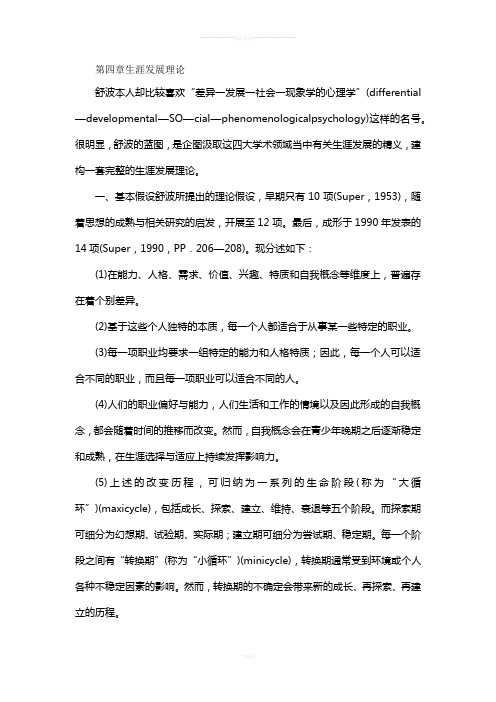
第四章生涯发展理论舒波本人却比较喜欢“差异一发展一社会一现象学的心理学”(differential —developmental—SO—cial—phenomenologicalpsychology)这样的名号。
很明显,舒波的蓝图,是企图汲取这四大学术领域当中有关生涯发展的精义,建构一套完整的生涯发展理论。
一、基本假设舒波所提出的理论假设,早期只有10项(Super,1953),随着思想的成熟与相关研究的启发,开展至12项。
最后,成形于1990年发表的14项(Super,1990,PP.206—208)。
现分述如下:(1)在能力、人格、需求、价值、兴趣、特质和自我概念等维度上,普遍存在着个别差异。
(2)基于这些个人独特的本质,每一个人都适合于从事某一些特定的职业。
(3)每一项职业均要求一组特定的能力和人格特质;因此,每一个人可以适合不同的职业,而且每一项职业可以适合不同的人。
(4)人们的职业偏好与能力,人们生活和工作的情境以及因此形成的自我概念,都会随着时间的推移而改变。
然而,自我概念会在青少年晚期之后逐渐稳定和成熟,在生涯选择与适应上持续发挥影响力。
(5)上述的改变历程,可归纳为一系列的生命阶段(称为“大循环”)(maxicycle),包括成长、探索、建立、维持、衰退等五个阶段。
而探索期可细分为幻想期、试验期、实际期;建立期可细分为尝试期、稳定期。
每一个阶段之间有“转换期”(称为“小循环”)(minicycle),转换期通常受到环境或个人各种不稳定因素的影响。
然而,转换期的不确定会带来新的成长、再探索、再建立的历程。
(6)生涯组型(careerpattern)的性质:包括从事职业的阶层水平、经过尝试和稳定地进人工作世界的经历、频率和持久性等。
这些均受到个人父母的社会经济地位、心理能力、教育、技巧、人格特质(包括需求、价值、兴趣、与自我概念)、生涯成熟及生涯机会的影响。
(7)在任何生涯阶段能否成功地因应环境需求和个体需求,取决于个人的“准备度”或“生涯成熟”。
Kelly之个人建构论( personal construct theory )

葉安華
陳奕安
紀妮玓
許晨韋
王爾伶
彭雪莉
指導教授:蔡順良老師 報告日期:100.12.05
George A. Kelly
有著冒險靈魂!
喜歡以非正統的角度去 思考及探索未知的事情
報告者:葉安華
2
豐富多元的生命經驗
• 出生於美國堪薩斯州的農場
– 嚴謹的基督教家庭 – 外公船長
• 教育歷程
– 小學在家教育 – 中學念四所 – 待過六所大學 分別獲得物理、數學、教育學、社
Ex.人都會做好事=>沒碰過做壞事的,相對極就沉隱了。從 來沒有知覺到與「好」相對的部分,是不可能有「好」 這個構念的。悉達多王子知覺到苦-樂。
報告者:許晨韋
13
構念的種類與構念系統
– 核心構念(core construct):個人最根本的構 念,只有在其他構念有了大改變時才會受影響。
– 外圍構念(peripheral construct):非基本構念, 可輕易被改變而不影響系統中的核心構念。
蘇聯、加勒比海、以及亞洲
報告者:葉安華
4
對人的看法
• 人就像科學家
• 運用推理的過程試著發展想法「構念(construct)」來預測事 件
• 人都是往未來的方向看
• 「是未來在逗弄人,而不是過去,一個人總是從過去的窗戶 探向未來」(Kelly, 1955, p.49)
• 人的主動性及自由意志
• 人有能力以建構性的方式來看待外在環境、思考世界 • 試著用不同的構念,就可以發展出新的策略,處理生活中的
老師說上課不准吃東西,A認為老師很機車,B認 為老師關心學生的學習品質。
為什麼一樣的環境刺激,每個人有不同的想法和反 應呢?
生命札记在生命教育情意教学上的应用
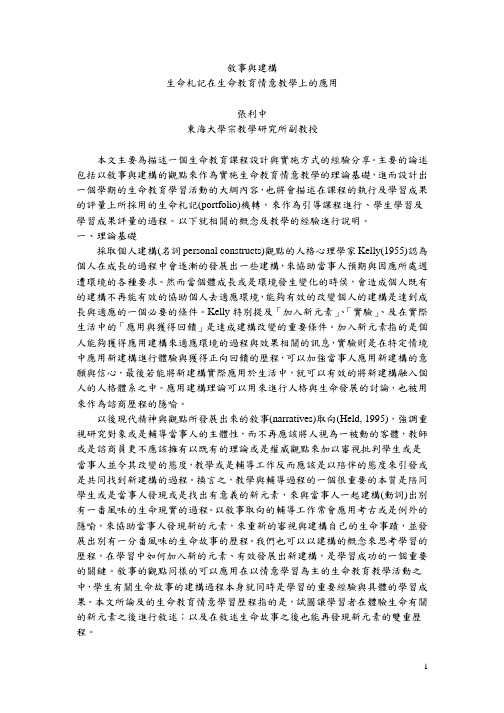
敘事與建構生命札記在生命教育情意教學上的應用張利中東海大學宗教學研究所副教授本文主要為描述一個生命教育課程設計與實施方式的經驗分享。
主要的論述包括以敘事與建構的觀點來作為實施生命教育情意教學的理論基礎,進而設計出一個學期的生命教育學習活動的大綱內容,也將會描述在課程的執行及學習成果的評量上所採用的生命札記(portfolio)機轉,來作為引導課程進行、學生學習及學習成果評量的過程。
以下就相關的概念及教學的經驗進行說明。
一、理論基礎採取個人建構(名詞personal constructs)觀點的人格心理學家Kelly(1955)認為個人在成長的過程中會逐漸的發展出一些建構,來協助當事人預期與因應所處週遭環境的各種要求。
然而當個體成長或是環境發生變化的時侯,會造成個人既有的建構不再能有效的協助個人去適應環境,能夠有效的改變個人的建構是達到成長與適應的一個必要的條件。
Kelly特別提及「加入新元素」、「實驗」、及在實際生活中的「應用與獲得回饋」是達成建構改變的重要條件。
加入新元素指的是個人能夠獲得應用建構來適應環境的過程與效果相關的訊息,實驗則是在特定情境中應用新建構進行體驗與獲得正向回饋的歷程,可以加強當事人應用新建構的意願與信心,最後若能將新建構實際應用於生活中,就可以有效的將新建構融入個人的人格體系之中。
應用建構理論可以用來進行人格與生命發展的討論,也被用來作為諮商歷程的隱喻。
以後現代精神與觀點所發展出來的敘事(narratives)取向(Held, 1995),強調重視研究對象或是輔導當事人的主體性,而不再應該將人視為一被動的客體,教師或是諮商員更不應該擁有以既有的理論或是權威觀點來加以審視批判學生或是當事人並令其改變的態度,教學或是輔導工作反而應該是以陪伴的態度來引發或是共同找到新建構的過程。
換言之,教學與輔導過程的一個很重要的本質是陪同學生或是當事人發現或是找出有意義的新元素,來與當事人一起建構(動詞)出別有一番風味的生命現實的過程。
人格心理学

心理学第十章人格
3
性格的类型
(一)英国心理学家培因(A.Bain)等人按知、情、意在性 格中的表现程度分为理智型、情绪型和意志型。 (二)瑞士心理学家荣格(C.G.Jung)按心理活动倾向而 分为外倾型和内倾型 (三)美国心理学家魏特金( H.A.Witkin) 按照个体独立程 度, 分为顺从型、独立型
心理学第十章人格
6
卡特尔的人格因素论
Raymoond B. cattel, 1905-1998 将人格分为: 表面特质(Surface trait):外部可观察到的;
根源特质(Source trait):稳定的、决定人格的基本因素。 是内在的,决定了表面特质。
心理学第十章人格
7
卡特尔16种人格因素问卷(Sixteen Personality Factor Questionaire K16PF)
(N5) 冲动性
(N6) 脆弱
心理学第十章人格
18
Big five
外倾性(E):
热情(EI) 乐群(E2)
自我肯定(E3)
活跃(E4)
刺激寻求(E5)
正情绪(E6)
心理学第十章人格
19
Big five
开放性(O):
幻想(O1) 审美(O2)
情感(O3)
行动(O4)
观念(O5)
价值(O6)
心理学第十章人格
情 绪
活 动 社 会
0.68
0.73 0.63
0.00
0.18 0.20
0.60
0.50 0.58
0.05
0.00 0.06
心理学第十章人格
40
2、环境作用
家庭因素 家庭经济的收入水平 家长的职业 家庭结构的健全程度 家庭的气氛 父母的教养态度 家庭子女的多少 儿童在家庭中的作用 父母的教养态度
2024心理学考研复试必备英语单词
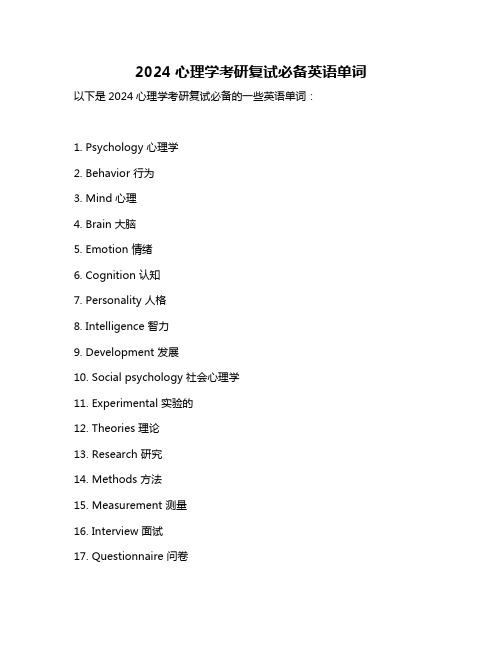
2024心理学考研复试必备英语单词以下是2024心理学考研复试必备的一些英语单词:1. Psychology 心理学2. Behavior 行为3. Mind 心理4. Brain 大脑5. Emotion 情绪6. Cognition 认知7. Personality 人格8. Intelligence 智力9. Development 发展10. Social psychology 社会心理学11. Experimental 实验的12. Theories 理论13. Research 研究14. Methods 方法15. Measurement 测量16. Interview 面试17. Questionnaire 问卷18. Experiment 实验19. Participants 参与者20. Variables 变量21. Sample 样本22. Control 组23. Experimental 组24. Dependent variable 因变量25. Independent variable 自变量26. Hypothesis 假设27. Theory 理论28. Research question 研究问题29. Null hypothesis 零假设30. Statistical significance 统计显著性31. Confidence interval 置信区间32. Effect size 效应量33. Meta-analysis 元分析34. Correlation 相关性35. Causality 因果关系36. Experimental design 实验设计37. Random assignment 随机分配38. Placebo effect 安慰剂效应39. Bias 偏见40. Extraneous variables 额外变量41. Experimental error 实验误差42. Internal validity 内效度43. External validity 外效度44. Construct validity 结构效度45. Confidentiality 机密性46. Ethics 伦理学47. Consent 同意书48. Deception 欺骗49. Anonymity 匿名性50. Blinding 盲法51. Control group 对照组52. Experimental group 实验组53. Sample size 样本量54. Power of test 检验力55. Null hypothesis significance testing(NHST)零假设显著性检验(NHST)56. Meta-analysis 元分析57. Confidence interval(CI)置信区间(CI)58. Odds ratio(OR)比值比(OR)59. Risk ratio(RR)危险比(RR)60. Hedges g 海哲思 g(效应量估计)。
量表题目及出处
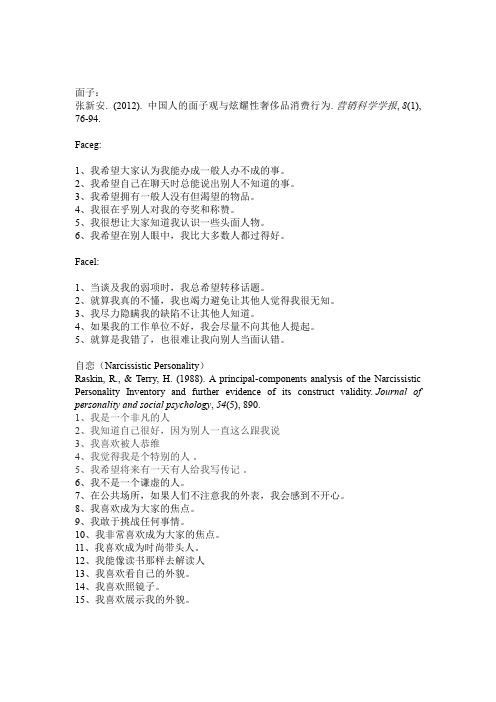
面子:张新安. (2012). 中国人的面子观与炫耀性奢侈品消费行为. 营销科学学报, 8(1), 76-94.Faceg:1、我希望大家认为我能办成一般人办不成的事。
2、我希望自己在聊天时总能说出别人不知道的事。
3、我希望拥有一般人没有但渴望的物品。
4、我很在乎别人对我的夸奖和称赞。
5、我很想让大家知道我认识一些头面人物。
6、我希望在别人眼中,我比大多数人都过得好。
Facel:1、当谈及我的弱项时,我总希望转移话题。
2、就算我真的不懂,我也竭力避免让其他人觉得我很无知。
3、我尽力隐瞒我的缺陷不让其他人知道。
4、如果我的工作单位不好,我会尽量不向其他人提起。
5、就算是我错了,也很难让我向别人当面认错。
自恋(Narcissistic Personality)Raskin, R., & Terry, H. (1988). A principal-components analysis of the Narcissistic Personality Inventory and further evidence of its construct validity. Journal of personality and social psychology, 54(5), 890.1、我是一个非凡的人2、我知道自己很好,因为别人一直这么跟我说3、我喜欢被人恭维4、我觉得我是个特别的人。
5、我希望将来有一天有人给我写传记。
6、我不是一个谦虚的人。
7、在公共场所,如果人们不注意我的外表,我会感到不开心。
8、我喜欢成为大家的焦点。
9、我敢于挑战任何事情。
10、我非常喜欢成为大家的焦点。
11、我喜欢成为时尚带头人。
12、我能像读书那样去解读人13、我喜欢看自己的外貌。
14、我喜欢照镜子。
15、我喜欢展示我的外貌。
长期导向LTOBearden, W. O., Money, R. B., & Nevins, J. L. (2006). A measure of long-term orientation: Development and validation. Journal of the Academy of Marketing Science, 34(3), 456-467.1、尊重传统对我很重要。
做自己心理导师作文
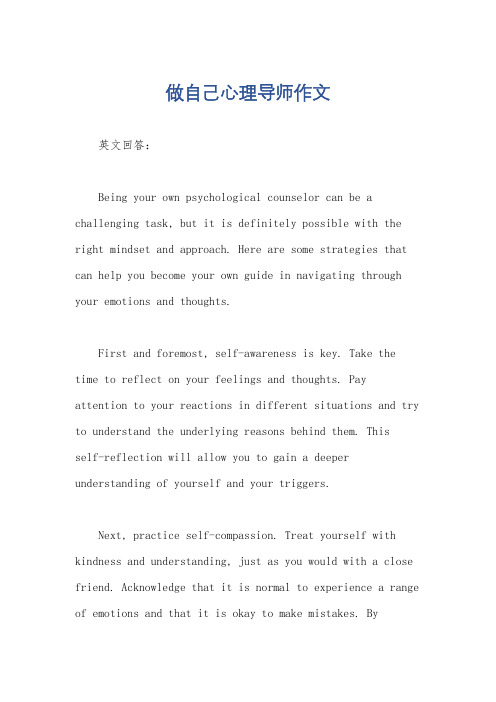
做自己心理导师作文英文回答:Being your own psychological counselor can be a challenging task, but it is definitely possible with the right mindset and approach. Here are some strategies that can help you become your own guide in navigating through your emotions and thoughts.First and foremost, self-awareness is key. Take the time to reflect on your feelings and thoughts. Payattention to your reactions in different situations and try to understand the underlying reasons behind them. Thisself-reflection will allow you to gain a deeper understanding of yourself and your triggers.Next, practice self-compassion. Treat yourself with kindness and understanding, just as you would with a close friend. Acknowledge that it is normal to experience a range of emotions and that it is okay to make mistakes. Byshowing yourself compassion, you can create a safe spacefor personal growth and healing.Another important aspect is developing effective coping strategies. Identify healthy ways to deal with stress and negative emotions. This could include engaging inactivities you enjoy, such as exercising, reading, or practicing mindfulness. Experiment with different techniques and find what works best for you.In addition, seek support from others. While you are your own counselor, it is still essential to have a strong support system. Surround yourself with people who uplift and encourage you. Share your thoughts and feelings with trusted friends or family members who can provide valuable insights and perspectives.Lastly, set realistic goals and celebrate your achievements. Take small steps towards personal growth and acknowledge your progress along the way. By setting achievable goals, you can build confidence and motivation to continue on your journey of self-discovery and self-improvement.中文回答:成为自己的心理导师可能是一项具有挑战性的任务,但只要拥有正确的心态和方法,是完全有可能实现的。
心理辅导教师个人成长的方式与途径
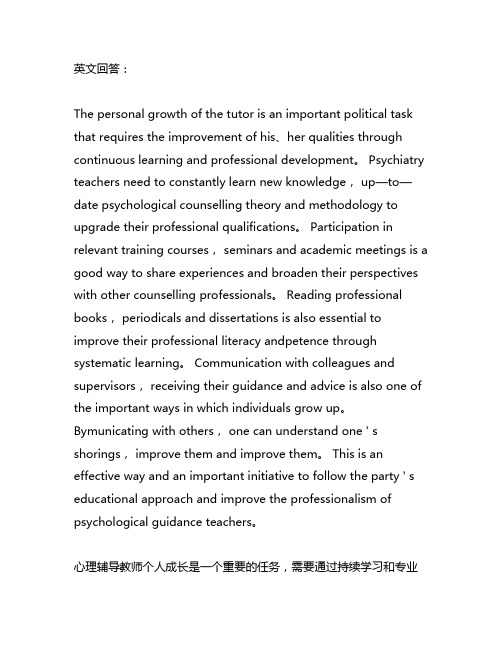
英文回答:The personal growth of the tutor is an important political task that requires the improvement of his、her qualities through continuous learning and professional development。
Psychiatry teachers need to constantly learn new knowledge, up—to—date psychological counselling theory and methodology to upgrade their professional qualifications。
Participation in relevant training courses, seminars and academic meetings is a good way to share experiences and broaden their perspectives with other counselling professionals。
Reading professional books, periodicals and dissertations is also essential to improve their professional literacy andpetence through systematic learning。
Communication with colleagues and supervisors, receiving their guidance and advice is also one of the important ways in which individuals grow up。
社科研究方法:构念

构念(Construct)Chao-Ying Joanne Peng构念(Construct)是社会科学家使用的概念,他们借此来解释某一现象的经验资料,或者将某个领域不可观察、不可测量的因素加以概念化,以构建一种理论。
具体来说,它可以表示为:(a)一个不可直接观察或测量的理念或概念(也即某个理论的某一方面);(b)从经验资料中推论或建构出来的一个概念,用以从整体上解释一个现象;(c)在其他可观测的经验概念或结果中显现出来的现象或概念的抽象的(而非操作性的)定义。
来源:工众号人文社科知识分享例如,根据某些智力理论的说法,逻辑推理就是一种构念,它代表了智力的一个方面。
逻辑推理不能直接观察;它是从诸如解决问题、批判性思维的能力等可观测的指标中推论出来的。
(学习)动力也是一个构念,它可以从有关学习的经验资料中推出来;它促进不同数据的整合,以建构一个有关学习的理论。
数学能力也是对一种行为的抽象定义;它的存在是从诸如数学成绩、数学焦虑(mathematical anxiety),以及某人曾经上过的数学必修、选修课等表现中推论出来的。
来源:工众号人文社科知识分享在构建个性和社会智力理论时,心理学家使用了普通人提供的语言和非语言的判断资料,以及多维度量(Multidmensional Scaling)来识别和确认各种构念(Jackson,2002)。
这种方法也同样成功地应用于心理病理学的临床判断研究(Jackson,2002)。
还有学者(Digma,1990)用因子分析(Factor Analysis)来研究亲和性、意志力、情绪稳定性以及理解力(或开放性)等人格维度。
这些构念(也即因子)是从测量人格的许多工具的相关(Correlation)或协方差(Covarian ce)矩阵中提取出来的。
利用结构方程模型等先进的统计推论技术,卡罗尔(Carroll,2002)说明了从这五个因素中还可以进一步提取出高阶因子来解释个人的人格差异,并协助诊断和治疗人格缺陷。
怎样才能成为一名心理咨询师英语作文
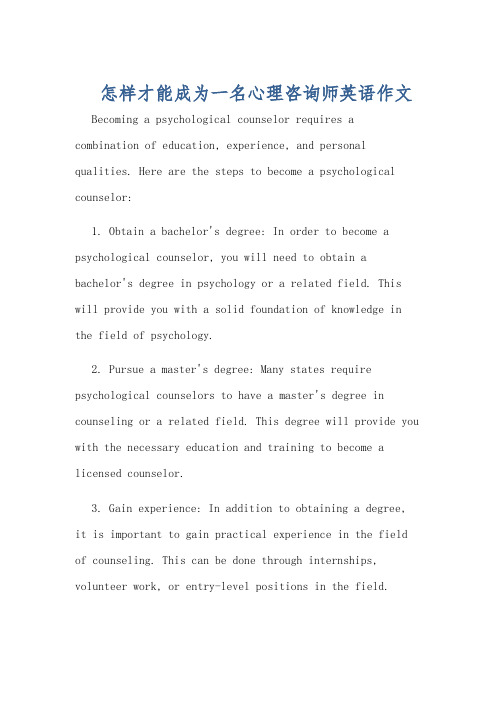
怎样才能成为一名心理咨询师英语作文Becoming a psychological counselor requires a combination of education, experience, and personal qualities. Here are the steps to become a psychological counselor:1. Obtain a bachelor's degree: In order to become a psychological counselor, you will need to obtain abachelor's degree in psychology or a related field. This will provide you with a solid foundation of knowledge in the field of psychology.2. Pursue a master's degree: Many states require psychological counselors to have a master's degree in counseling or a related field. This degree will provide you with the necessary education and training to become a licensed counselor.3. Gain experience: In addition to obtaining a degree,it is important to gain practical experience in the field of counseling. This can be done through internships, volunteer work, or entry-level positions in the field.4. Obtain licensure: In most states, psychological counselors are required to be licensed in order to practice. This typically involves completing a certain number of supervised clinical hours and passing a licensing exam.5. Develop personal qualities: In addition to education and experience, it is important for psychologicalcounselors to possess certain personal qualities, such as empathy, patience, and good communication skills.成为一名心理咨询师需要一定的教育背景、经验和个人素质。
我想成为心理学家的英语作文

我想成为心理学家的英语作文英文回答:Pursuing a career as a psychologist demands a deep-seated passion for understanding human behavior, coupled with an inexhaustible curiosity about the complexities of the human mind. It requires a rigorous academic journey, meticulous research, and unwavering commitment to ethical practices. Yet, the rewards of this arduous path are profound, as psychologists play a pivotal role in improving mental health outcomes, fostering personal growth, and unlocking human potential.To embark on this fulfilling journey, one must first obtain a solid foundation in psychology at the undergraduate level. This entails exploring foundational concepts, theories, and research methods that form the backbone of the discipline. A strong undergraduate education not only provides a comprehensive overview of the field but also develops critical thinking, analytical, andcommunication skills essential for success in graduate studies.Upon completing an undergraduate degree, aspiring psychologists typically pursue a doctoral degree, either a Ph.D. (Doctor of Philosophy) or a Psy.D. (Doctor of Psychology). These advanced degrees involve rigorous coursework, extensive research, and supervised clinical practice. The curriculum delves into advanced theories, research methodologies, and specialized areas within psychology, such as clinical, developmental, cognitive, or social psychology. Research forms an integral part of doctoral training, with students conducting original research projects that contribute to the advancement of psychological knowledge. This research experience not only enhances critical thinking and problem-solving abilitiesbut also prepares individuals for future research endeavors.Supervised clinical practice is an indispensable component of doctoral training, providing students with hands-on experience in applying psychological principles to real-world settings. Under the guidance of licensedpsychologists, students gain proficiency in conducting intake assessments, administering psychological tests, providing therapy, and developing treatment plans. This clinical experience not only builds practical skills but also fosters ethical decision-making and cultural sensitivity.After completing their doctoral training, psychologists must obtain licensure to practice independently. Licensure requirements vary across jurisdictions but generally include passing a standardized examination and completing a specified number of supervised practice hours. Licensed psychologists are authorized to provide a wide range of psychological services, including therapy, psychological assessment, and consultation.The career path of a psychologist offers diverse opportunities for professional growth and specialization. Psychologists can work in various settings, such as private practice, hospitals, schools, clinics, and research institutions. They can specialize in different areas of psychology, such as clinical, counseling, forensic, orneuropsychology. With experience and advanced training, psychologists can pursue leadership roles in research, teaching, or administration.The journey to becoming a psychologist is undoubtedly challenging, but it is also incredibly rewarding. Psychologists have the privilege of making a meaningful impact on the lives of others, helping individuals overcome mental health challenges, navigate life transitions, and achieve their full potential. The pursuit of psychological knowledge and the application of evidence-based practices provide psychologists with a profound sense of purpose and fulfillment.中文回答:想要成为一名心理学家的英语作文。
英语作文我想当心理学家
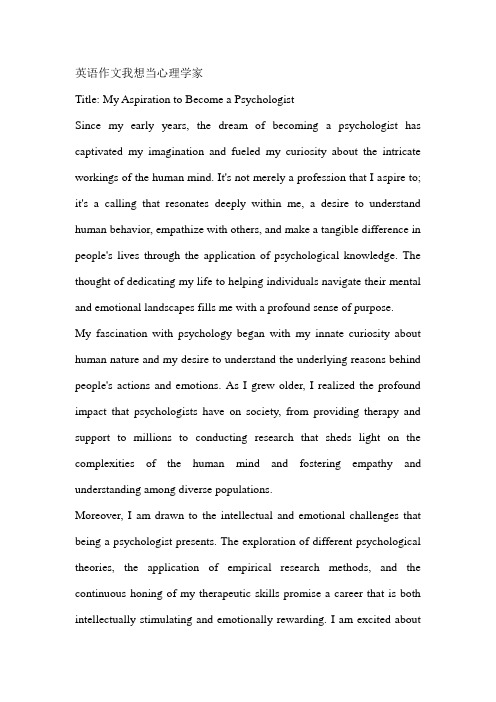
英语作文我想当心理学家Title: My Aspiration to Become a PsychologistSince my early years, the dream of becoming a psychologist has captivated my imagination and fueled my curiosity about the intricate workings of the human mind. It's not merely a profession that I aspire to; it's a calling that resonates deeply within me, a desire to understand human behavior, empathize with others, and make a tangible difference in people's lives through the application of psychological knowledge. The thought of dedicating my life to helping individuals navigate their mental and emotional landscapes fills me with a profound sense of purpose.My fascination with psychology began with my innate curiosity about human nature and my desire to understand the underlying reasons behind people's actions and emotions. As I grew older, I realized the profound impact that psychologists have on society, from providing therapy and support to millions to conducting research that sheds light on the complexities of the human mind and fostering empathy and understanding among diverse populations.Moreover, I am drawn to the intellectual and emotional challenges that being a psychologist presents. The exploration of different psychological theories, the application of empirical research methods, and the continuous honing of my therapeutic skills promise a career that is both intellectually stimulating and emotionally rewarding. I am excited aboutthe prospect of working with individuals from all walks of life, helping them overcome challenges, and facilitating their personal growth and development.I also believe in the power of psychology to bring change. Psychologists have the unique ability to empower individuals, to foster self-awareness, and to promote mental health and well-being. I aspire to be a psychologist who not only provides therapy but also actively seeks opportunities to make a lasting difference in people's lives through meaningful and evidence-based interventions that address a wide range of mental health concerns.Furthermore, I am inspired by the potential of psychology to contribute to social progress. As a psychologist, I have the opportunity to work in various settings, from clinical environments to research institutions, and to be part of efforts that aim to improve mental health services, reduce stigma, and promote inclusive and empathetic societies.In conclusion, my aspiration to become a psychologist is deeply rooted in my desire to understand human behavior, empathize with others, and make a positive difference in people's lives through the application of psychological knowledge. It is a vocation that requires dedication, perseverance, and a commitment to continuous learning and ethical practice. I am eager to embark on this noble journey, ready to face the challenges, embrace the rewards, and continuously strive to be the bestversion of a psychologist I can be. Becoming a psychologist is not just a career choice for me; it's a mission to uphold the values of empathy, understanding, and mental health advocacy through the art and science of psychology.。
怎样才能成为一名心理咨询师英语作文

怎样才能成为一名心理咨询师英语作文Becoming a psychotherapist is a rewarding but demanding career path, requiring a unique blend of academic knowledge, clinical skills, and personal qualities.It's a profession built on empathy, understanding, and the ability to guide individuals through their emotional and mental landscapes. The journey to becoming a psychotherapist involves a significant commitment to education, training, and personal development. The foundation of this profession lies in a strong academic background. Aspiring psychotherapists typically begin their journey by pursuing a bachelor's degree in psychology or a related field. This foundational education provides a comprehensive understanding of human behavior, cognition, and the complexities of the human mind. Courses in abnormal psychology, developmental psychology, and social psychology are essential, offering insights into various mental health conditions, developmental stages, and the interplay between individuals and their environment. Building upon this bedrock of knowledge, aspiring therapists then pursue a master's degree in psychotherapy, counseling, or a related discipline. This advanced education delves deeper into therapeutic approaches, ethical considerations, and the nuances of clinical practice. Students gain exposure to different theoretical orientations, such as psychodynamic therapy, cognitive-behavioral therapy, and humanistic therapy, each offering a unique lens through which to understand and address mental health concerns. This period also marks the beginning of supervised clinical experience, where students apply their theoretical knowledge in real-world settings, honing their skills under the guidance of experienced practitioners. Clinical experience is the cornerstone of a psychotherapist's development. This immersive training provides the opportunity to work directly with clients, apply therapeutic techniques, and develop the essential interpersonal skills that form the foundation of effective therapy. Under the watchful eye of supervisors, budding therapists conduct assessments, formulate treatment plans, and facilitate individual and group therapy sessions. This hands-on experience allows them to refine their skills, navigate the complexities of therapeutic relationships, and gain confidence in their ability to support clients through their challenges. Beyond academic qualifications and clinical experience, certain personal qualitiesare indispensable for success as a psychotherapist. Empathy, the ability to understand and share the feelings of another, is paramount. Therapists must beable to connect with their clients on an emotional level, creating a safe and supportive space for them to explore their innermost thoughts and feelings. Active listening skills are crucial, enabling therapists to truly hear and understandtheir client's narratives. Patience is another essential virtue, as thetherapeutic process often unfolds gradually, requiring therapists to support their clients through moments of frustration, resistance, and emotional vulnerability. The journey to becoming a psychotherapist doesn't end with obtaining licensure.It's an ongoing process of professional development and lifelong learning. Staying abreast of the latest research, attending workshops and conferences, and engagingin regular supervision are essential for maintaining competency and ensuringethical practice. The field of mental health is constantly evolving, with new therapeutic approaches, research findings, and understandings of mental health conditions emerging regularly. By embracing continuous learning, therapists can ensure they are providing their clients with the most effective and up-to-date care. Becoming a psychotherapist is a commitment to personal and professional growth, fueled by a desire to make a meaningful difference in the lives of others. It's a journey of continuous learning, self-reflection, and refinement of one's skills, all driven by the ultimate goal of providing compassionate and effective mental health care. The path is demanding, but the rewards of empowering individuals to navigate life's challenges and achieve emotional well-being make it a truly fulfilling vocation.。
大学生自我控制量表的修订

大学生自我控制量表的修订谭树华,郭永玉(华中师范大学心理学院,湖北武汉430079)【摘要】目的:修订自我控制量表(SCS),考察其心理测量学指标。
方法:对799名武汉市大学生进行测查,对量表进行验证性因素分析和信、效度检验。
结果:验证性因素分析的结果显示,SCS的五因素结构拟合较好。
SCS的内部一致性信度为0.862,重测信度为0.850。
以被试的平均学分绩、人际关系满意感、生活满意感、心理健康水平为效标,与SCS的相关分别为0.146;0.280;0.163;0.317。
结论:SCS符合心理测量学的要求;可作为测量我国大学生自我控制能力的工具。
【关键词】自我控制量表;信度;效度中图分类号:R395.1文献标识码:A文章编号:1005-3611(2008)05-0468-03Revision of Self-Control Scale for Chinese College StudentsTAN Shu-hua,GUO Yong-yuSchool of Psychology,Central China Normal University,Wuhan430079,China【Abstract】Objective:To revise the Self-Control Scale(SCS).Methods:Data were collected from a sample of799col-lege students of Wuhan and analyzed by Confirmatory Factor Analysis,reliability test and validity test.Results:The re-sults of Confirmatory Factor Analysis showed that the revised SCS was five-factor construct and had good construct validi-ties.The Cronbach’sαcoefficient of the SCS scale was0.862,and the reliability coefficient of the test-retest stability co-efficient was0.850.The correlation between total score of SCS and that of Grade Point Average(GPA)was0.146;the cor-relation between total score of SCS and that of Interpersonal Satisfaction Scale(ISS)was0.280;the correlation between total score of SCS and that of Life Satisfaction Scale(LSS)was0.163,and the correlation between total score of SCS and that of General Health Questionnaire(CHQ)was0.317.Conclusion:The revised scale of SCS has good psychometric quality and can be used in Chinese college students.【Key words】Self-control Scale;Reliability;Validity人们最健康、最幸福的时候就是自我和环境完全匹配的时候,只是日常生活中个体和环境很难完全匹配,但匹配的程度可以通过调整自我来得到最大化地提升[1]。
成人素质希望量表的信效度检验
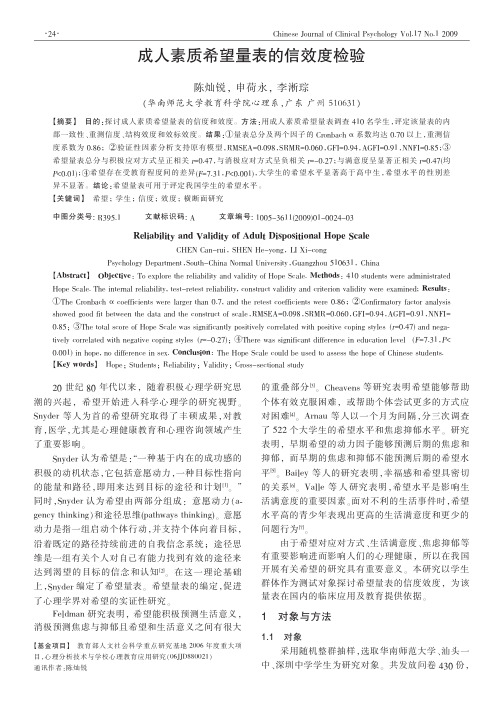
成人素质希望量表的信效度检验陈灿锐,申荷永,李淅琮(华南师范大学教育科学院心理系,广东广州510631)【摘要】目的:探讨成人素质希望量表的信度和效度。
方法:用成人素质希望量表调查410名学生,评定该量表的内部一致性、重测信度、结构效度和效标效度。
结果:①量表总分及两个因子的Cronbach α系数均达0.70以上,重测信度系数为0.86;②验证性因素分析支持原有模型,RMSEA=0.098,SRMR=0.060,GFI=0.94,AGFI=0.91,NNFI=0.85;③希望量表总分与积极应对方式呈正相关r =0.47,与消极应对方式呈负相关r =-0.27;与满意度呈显著正相关r =0.47(均P <0.01);④希望存在受教育程度间的差异(F =7.31,P <0.001),大学生的希望水平显著高于高中生,希望水平的性别差异不显著。
结论:希望量表可用于评定我国学生的希望水平。
【关键词】希望;学生;信度;效度;横断面研究中图分类号:R395.1文献标识码:A文章编号:1005-3611(2009)01-0024-03Reliability and Validity of Adult Dispositional Hope ScaleCHEN Can-rui ,SHEN He-yong ,LI Xi-congPsychology Department ,South-China Normal University ,Guangzhou 510631,China【Abstract 】Objective :To explore the reliability and validity of Hope Scale.Methods :410students were administratedHope Scale.The internal reliability,test-retest reliability,construct validity and criterion validity were examined;Results :①The Cronbach αcoefficients were larger than 0.7,and the retest coefficients were 0.86;②Confirmatory factor analysis showed good fit between the data and the construct of scale ,RMSEA=0.098,SRMR=0.060,GFI=0.94,AGFI=0.91,NNFI=0.85;③The total score of Hope Scale was significantly positively correlated with positive coping styles (r =0.47)and nega -tively correlated with negative coping styles (r =-0.27);④There was significant difference in education level (F =7.31,P <0.001)in hope,no difference in sex.Conclusion :The Hope Scale could be used to assess the hope of Chinese students.【Key words 】Hope ;Students ;Reliability ;Validity ;Cross-sectional study【基金项目】教育部人文社会科学重点研究基地2006年度重大项目,心理分析技术与学校心理教育应用研究(06JJD880021)通讯作者:陈灿锐20世纪80年代以来,随着积极心理学研究思潮的兴起,希望开始进入科学心理学的研究视野。
怎样成为心理学家英文作文

怎样成为心理学家英文作文下载温馨提示:该文档是我店铺精心编制而成,希望大家下载以后,能够帮助大家解决实际的问题。
文档下载后可定制随意修改,请根据实际需要进行相应的调整和使用,谢谢!并且,本店铺为大家提供各种各样类型的实用资料,如教育随笔、日记赏析、句子摘抄、古诗大全、经典美文、话题作文、工作总结、词语解析、文案摘录、其他资料等等,如想了解不同资料格式和写法,敬请关注!Download tips: This document is carefully compiled by theeditor. I hope that after you download them,they can help yousolve practical problems. The document can be customized andmodified after downloading,please adjust and use it according toactual needs, thank you!In addition, our shop provides you with various types ofpractical materials,such as educational essays, diaryappreciation,sentence excerpts,ancient poems,classic articles,topic composition,work summary,word parsing,copyexcerpts,other materials and so on,want to know different data formats andwriting methods,please pay attention!Becoming a psychologist is an intriguing career paththat requires dedication and a passion for understandingthe human mind. It's a journey that involves years of study, practical experience, and a commitment to helping others. So, how does one become a psychologist? Let's explore the steps involved.Firstly, obtaining a bachelor's degree in psychology is a crucial starting point. This undergraduate program provides a foundation in various psychological theories and concepts. It covers subjects like cognitive psychology, social psychology, and abnormal psychology. Through coursework and assignments, students gain a basic understanding of the field and develop critical thinking skills.After completing a bachelor's degree, aspiring psychologists usually pursue a master's degree. This advanced program allows students to specialize in aparticular area of psychology, such as clinical psychology or counseling psychology. During this phase, they delve deeper into their chosen field, studying advanced theories and research methods. They may also have the opportunity to gain practical experience through internships or research projects.Once the master's degree is completed, many psychologists choose to pursue a doctoral degree. This can be either a Ph.D. (Doctor of Philosophy) or a Psy.D. (Doctor of Psychology). A Ph.D. program focuses more on research and academic pursuits, while a Psy.D. program emphasizes clinical training and practical experience. Both paths require students to complete a dissertation or research project, which contributes to the overall knowledge in the field.After obtaining a doctoral degree, psychologists usually need to complete a period of supervised clinical experience. This can involve working in a hospital, clinic, or private practice under the guidance of a licensed psychologist. During this time, they gain hands-onexperience in conducting assessments, providing therapy, and diagnosing mental health disorders. This practical experience is essential for developing the skills necessary to work independently as a psychologist.Finally, to become a licensed psychologist, individuals must pass a licensing exam. The requirements for licensure vary by country or state, but typically involve passing a standardized examination that assesses knowledge and competency in the field of psychology. Once licensed, psychologists can practice independently, diagnose mental health disorders, and provide therapy to individuals, couples, or families.In conclusion, becoming a psychologist requires a combination of education, practical experience, and licensure. It is a rewarding career that allows individuals to make a meaningful impact on the lives of others. So, if you have a passion for understanding the human mind and a desire to help people, a career in psychology may be the perfect fit for you.。
- 1、下载文档前请自行甄别文档内容的完整性,平台不提供额外的编辑、内容补充、找答案等附加服务。
- 2、"仅部分预览"的文档,不可在线预览部分如存在完整性等问题,可反馈申请退款(可完整预览的文档不适用该条件!)。
- 3、如文档侵犯您的权益,请联系客服反馈,我们会尽快为您处理(人工客服工作时间:9:00-18:30)。
Personal construct psychology methods for qualitative researchViv Burr a *,Nigel King a and Trevor Butt b,1aSchool of Human and Health Sciences,University of Hudders field,Queensgate,Hudders field,HD13DH,UK;b Emeritus Reader in Psychology,University of Hudders field,Queensgate,Hudders field,HD13DH,UK(Received 5March 2012;final version received 12September 2012)Personal construct psychology (PCP)has always been better known for its methods than its theory,but many researchers are not aware of the range of qualitative methods offered by a PCP approach.We argue that PCP methods have been overlooked as tools for the qualitative researcher and that they satisfy some key requirements of much qualitative research,such as the capacity to provide in-depth insight into personal experience,to establish a ‘democratic ’relationship between researcher and participants and to represent the partici-pant ’s ‘voice ’.We illustrate several of these methods,drawing on research examples.We show how they enable participants to articulate their experience,and how they may be used as part of an in-depth interview.We conclude that Personal Construct methods provide opportunities for qualitative researchers to create innovative ways of researching personal experience.Keywords:personal construct psychology;PCP;role repertory test;interview;constructivism;identityIntroductionPersonal construct psychology (PCP)(Kelly,1955)has always been better known for its methods than its theory,but many researchers are not aware of the range of qualitative methods offered by a PCP approach.The Repertory Grid,arguably PCP ’s most well-known method,has been principally used as a quantitative,statisti-cal technique.Employed in a wide range of fields,it has been used not only by PCP researchers but also by many others not adopting this theoretical framework.For example,Jones,Harris,and Waller (1998)used grids to study expectations of an exercise prescription scheme,while Hewitt (2005)used both PCP theory and repertory grid method to investigate music teachers ’perceptions of their students ’abilities.Although this and other PCP methods are now being acknowledged as offering great potential for qualitative work (see,for example,Fransella,2005),PCP methods are still relatively underused by qualitative researchers.In this paper,we will make a case for PCP methods as useful and flexible qualitative methods that are congruent with other theoretically related approaches,namely constructiv-ism and broadly phenomenological approaches.We will argue that PCP provides*Corresponding author.Email:v.burr@ 1RetiredInternational Journal of Social Research Methodology ,2014V ol.17,No.4,341–355,/10.1080/13645579.2012.730702Ó2012Taylor &Francis342V.Burr et al.opportunities to extend and enrich the methods currently predominantly used byqualitative researchers and we will illustrate this through examples.PCP was devised by Kelly,who was working as a clinical psychologist in theUSA during the Great Depression of the1930s.He saw PCP as an alternative to the mainstream psychologies of the day,behaviourism and psychoanalysis,withwhich he became dissatisfied.PCP focuses on subjective experience.It asserts thatevents may be interpreted by people in a potentially infinite variety of ways,andKelly(1955)called this‘constructive alternativism’.The meanings with which aperson endows events,how they‘construe’them,are seen as key to understandingtheir thoughts,emotions and conduct.Events are construed through a system ofmeaning that each individual builds for themselves.This‘construct system’is a lensthrough which the world is perceived,and consists of a set of bipolar dimensions or‘constructs’,such as friendly vs.hostile,interesting vs.dull,etc.,which the per-son uses to interpret their experience(although this process often lies outside ofimmediate awareness).Kelly devised the repertory grid and other methods to enablehim and his patients to gain insight into their construing.PCP clinicians andresearchers have since developed a considerable number of further techniques;thesemay be used within a PCP theoretical framework,but can also be adopted in awider range of approaches that sit at the intersection between constructivism andphenomenology.In its epistemological framework,PCP can be understood as one of a number ofapproaches that Madill,Jordon,and Shirley(2000)refer to as‘contextual construc-tionism’,which is distinct from both realism and radical constructionism:‘reality’isnot singular,and is actively constructed through our interpretative processes.Whileone account of reality can thus be regarded as no more‘accurate’than another,some accounts may be more useful or facilitative for the person.This is a key ideawithin PCP,and is consistent with Strauss and Corbin’s development of groundedtheory(e.g.Strauss&Corbin,1990).In its emphasis upon individual experience and knowledge as a useful construction,PCP is grounded in both pragmatism andphenomenology(Butt,2005).PCP is phenomenological,in that it is concerned withthe world as it is perceived by the person,the‘phenomena’that present themselvesto consciousness.PCP theory and methods are epistemologically compatible with approaches thattake seriously subjective experience and/or that challenge deterministic or essential-ist models of the person.PCP rejects causality and determinism as explanatory con-cepts in human behaviour and experience;rather,it attends to the constructive processes giving rise to our experience and its methods are specifically designed toattend to the nature of subjectivity.PCP focuses upon the‘voice’of participants ingathering research data by being careful to describe events in terms used by partici-pants themselves;in giving verbal and written labels to the constructs,care is takento adopt the words and terms used by the participant,which helps to privilege their ‘voice’in thefindings and to ensure that the interpretative process remains in their control rather than being taken over by the researcher.This bears witness to theclinical origin of many PCP methods,where exploration of the client’s world view is the focus,rather thanfinding answers to specific research questions.PCP meth-ods are therefore well suited to qualitative research where such exploration is the aim.Research,like therapy,is a joint interpretative process but in PCP methods, the participant’s perspective always remains the priority.Whereas other methods of analysis,such as Interpretative Phenomenological Analysis(Smith&Osborn,International Journal of Social Research Methodology343 2003),rely principally upon the researcher’s interpretation of an interview transcript some time after the interview.A characteristic of PCP methods is the greater time spent during data gathering in agreeing construct labels and their meanings with the participant.There are a number of further distinctive features of PCP methods.PCP’s clinical origin has led to the development of a variety of techniques particularly effective for addressing issues of change.Much PCP research continues to have a clinical focus, however this renders its methods particularly appropriate for action research where change is the desired outcome,for example in community psychology.PCP methods can be particularly effective in researching experiences that are hard for participants to articulate;the elicitation of a person’s bipolar constructs typically entails the com-parison of two or three concrete examples from their experience(termed‘elements’). This focus on concrete events can enable participants to overcome the difficulties of expressing abstract ideas,and offers the researcher strategies for accessing accounts which reach beyond socially desirable or common sense responses.The aim of analysis in the case of different qualitative approaches may vary,for example,to describe commonalities in lived experience,to identify culturally avail-able narratives of a particular experience or to give legitimacy to the experiences of relatively powerless groups;nevertheless,a very common method of data collection is the in-depth interview.However,interviewing requires much skill.The interviewer needs to use probes and prompts effectively to gain relevant material(King& Horrocks,2010).More importantly,where the research topic is one that is psycho-logically and socially complex,as is often the case in qualitative research,it can be difficult for people to articulate and report their experience in response to interview questions.Consider the following research questions:What is attractive or sexually appealing to a person?Why do people want to have children?Why do women want to be thin?Often we cannot simply say or feel unable to do more than draw upon currently socially available narratives.Of course,PCP methods are not unique here. Literature on interviewing about difficult and sensitive topics(e.g.Lee,1993; Mercer,2008)suggests that getting to hard-to-reach meaning is inevitably time-con-suming;it requires the researcher to build rapport with the participant,to explore more accessible aspects of experiencefirst and to use multiple probes to‘get below the surface’.Techniques other than interviews,such as photo-elicitation and audio diaries,have been used in research on‘difficult’areas to enable participants to have greater agency than they would in a conventional interview(Johnson,2011;Pink, 2007;Sargeant&Gross,2011).PCP methods have three potential advantages over such strategies.First,they are intrinsically participant-led,but are used in collabora-tion with the researcher.This avoids the uncertainty about‘doing it right’that some participants may feel when left on their own to produce the required material. Secondly,PCP methods are less reliant on the verbalfluency of participants than interviews,audio diaries or visual methods,where people are asked to explain the meaning of what they have produced.Thirdly,PCP methods tend to be very effi-cient;in our experience participants are generally able to carry out the tasks required by the methods described below in a relatively short period of time.In the remainder of this paper,we will illustrate several methods,chosen to indi-cate something of the range of issues that PCP techniques may be used to address.344V.Burr et al.Interviewing using the Role Construct Repertory TestConventional interview methods can raise particular challenges when participants find it difficult or threatening to speak about their experience.This can often be the case with research in health and social care settings.Qualitative researchers using interviews mustfind appropriate and facilitative techniques that can enable such participants to fully contribute their views.For example,Kelly(2007)developed a number of concrete visual aids to enable children with learning disabilities to take part in her research and Conolly(2008)developed effective task-based interviews in her work with excluded children.The use of concrete or specific examples from experience can be a simple but powerful technique and is one of the things that PCP methods can bring to the interview.Through inviting interviewees to draw comparisons between different people,events or things,they may be enabled to reach for meaning that is not immediately apparent to them.Thefirst stage in completing a repertory grid is the elicitation of constructs,and for this,Kelly(1955)typically used the‘Role Construct Repertory Test’.Despite its name,it is not a‘test’at all but a particularly fruitful method for encouraging reflection on experience.It is in itself a potentially powerful qualitative method,yet few researchers consider using it without the subsequent completion and analysis of a grid.The person isfirst asked to think of,say,a number of people with whom they have some form of relationship,including some that they like and some they dislike.Together with‘self’this list of people constitutes the‘elements’to be used.The interviewee is then presented with three elements,chosen at random,and asked to consider ways in which two of them are similar and different from the third.An answer might,for example,be‘Maria and Yasmin are kind,but John is harsh’.In this example,‘kind vs.harsh’is a construct.The constructs are written down with one‘pole’of the construct on the left and the other on the right.This process of comparing elements and recording the emerging constructs continues until the interviewee feels they have articulated all the dimensions of meaning important to them.Constructs are labelled using the participant’s own words,as outlined earlier.The process of completing the Role Construct Repertory Test can itself be one that enables the interviewee to reflect upon their perception of them-selves and their world,and more can be learned by probing further on the nature of the contrasts that are so meaningful to the person.This inspection of the constructs is done as a joint endeavour between inter-viewer and interviewee.It is a‘democratic’process in which the suggestions of the researcher are just that—they are not privileged interpretations.Throughout the interview,participants are encouraged to reflect on their experience and the partici-pant’s own perceptions of the emerging material are continually fed back into the process.It is important not to regard the constructs as revealing‘the truth’about the person.Like data gathered through other qualitative methods,and consistent with a contextual constructionist approach,they are a product of a particular interac-tion,a‘snap shot’of the person’s world view taken at a particular time and in a particular context.Used in this way,the role repertory test produces a different kind of interview from the traditional,semi-structured format and enables it to quickly focus on important aspects of experience that might otherwise be hard for the person to reach for and articulate.Although hand-written notes on emerging construct dimensions are normally taken during the interview,transcriptions of audio recordings allow forInternational Journal of Social Research Methodology345 these to be later checked and elaborated.In some research contexts,audio recording interviews can be experienced as threatening by participants(Holt&Pamment, 2010)and in such circumstances,although producing less rich data,the constructs emerging from the role repertory test can simply be recorded by hand during the interview.In order to show in more detail how the method may be used in qualitative research,we will illustrate this through a small pilot study on women’s identities conducted by two of the authors.The research illustrates how the role repertory test interview can be an effective tool in enabling researchers and participants to explore potentially sensitive personal issues,core values and personal change through topics that are familiar and interesting to participants.Our personal experience and informal discussion with friends and colleagues had suggested that clothes,and shoes in particular,are a rich source of personal meaning for many women today and that these meanings are connected to their sense of self and to their public persona.We therefore conducted a small pilot study to investigate the personal identity meanings that a range of shoes held for women (Burr&King,2009).Although,on the face of it,the topic may seem frivolous,we will show that this focus on concrete aspects of everyday experience can be a powerful way to explore issues which might not emerge so freely if addressed directly.Personal identity is a complex and elusive matter;what kind of person we feel ourselves to be,and what is central to this self-concept,can be difficult to articulate.For example,in research-ing the nature of performing everyday professional identities,one of the authors has found that interview probes simply lead to more detailed descriptions of abstract, official versions of professional roles(Ross,King,&Firth,2005).The focus on specific and concrete things and events that is characteristic of PCP methods effec-tively ameliorates these problems.Three women between the ages of30and45took part,who we will call Margaret, Bridget and Lucy.We asked each participant to compare images of various shoes and to talk about the similarities and differences that they ing shoes as the ‘elements’quickly led to the emergence of important identity issues for the partici-pants,and these were then further explored through interview probes.We presented each participant with a selection of three images at a time,asking in what way any two are similar and different from the third–Kelly’s operational definition of a construct.We asked the women to think not only about the shoes but about the kind of person or personality they suggest.We repeated this with different combinations of images and made notes of the similarities and,importantly,the contrasts that partici-pants reported.For example,when shown the images of three pairs of shoes,Bridget identified one pair as‘sexy’.The logical opposite of‘sexy’is‘not sexy’,but when prompted with‘as opposed to…?’she responded‘old-fashioned’.We then went back over our notes with the women,checking and clarifying the nature of the constructs that had emerged,agreeing labels for the constructs using their own words and phrases,in each case exploring their opposite or‘contrast’term and using probes to further explore particularly interesting issues.The con-structs that were identified and agreed for each of the participants are shown in Table1.This method gave us insight into what appeared to be very important aspects of participants’sense of self;many of the constructs that emerged during the inter-views were highly salient to personal identity and not simply‘just about shoes’.WeT a b l e 1.C o n s t r u c t s e l i c i t e d i n a p i l o t s t u d y o f w o m e n ’s i d e n t i t i e s .P a r t i c i p a n t sM a r g a r e tB r i d g e tL u c yC o n s t r u c t s e l i c t e dY o u n g e r ———————————————————————O l d e r S t r e a m l i n e d /n e a t ———————————G a r i s h /i n y e r f a c e C o m f o r t a b l e ————————————————————N o t c o m f o r t a b l eF a s h i o n a b l e ——————————N o t f a s h i o n a b l eS e x y —————————————————————A p a r o d y o f s e x i n e s s C o n fid e n t f e m i n i n e —————————H e l p l e s s f e m i n i n eP r a c t i c a l c o m f o r t a b l e ———————————F o r a p p e a r a n c eH e t e r o s e x u a l —————————————————————————————G a y /b i S a f e t y ———————————————————————————————————————————F u n N o t l e a t h e r —————D o e s n ’t g i v e a d a m n C o m f o r t a b l e /f u n c t i o n a l ——————N o t p r a c t i c a l T o n e d d o w n s e x u a l ————————————O v e r t l y s e x u a l C l a s s i c a l —————————————————N o t c l a s s i c a l Y o u n g ————————————————————————O l d e r I n f o r m a l —————————————————————————————F o r m a lE l e g a n t ———————————————————————S l o p p y C a n w e a r a n y t i m e ————A n ‘o c c a s i o n ’s h o eN o t m a k i n g a s t a t e m e n t –M a k i n g a s t a t e m e n tN o t w o r n t o l o o k s e x y —————W o r n t o l o o k s e x y G i v e s m y b o d y p l e a s i n g s h a p e ——————D o e s n ’t E v e r y d a y w e a r ————————————D r e s s yS e x y —————————————————————O l d f a s h i o n e d C o o l ———————————————————N o t c o o lE x t r a v e r t ————————————————————I n t r o v e r tC o n t e m p o r a r y —————L o o k s c h e a p /t r a s h y /l o w c o s t346V .Burr et al.International Journal of Social Research Methodology347 will focus here on three examples from ourfindings,which illustrate how the reper-tory test interview can be used to explore sensitive issues like sexuality,as well as other important identity issues such as core values and personal change.The opportunity to reflect upon their own construing produced some of our rich-estfindings.For example,Bridget produced a dimension of‘girliness’vs.‘domina-trix,fancy dress’.She said‘girliness’implied sexual orientation:‘a girly shoe with a heel and the rest of it sends that message that that’s a straight woman,whereas other shoes send other messages’.Another construct important to her was whether a shoe gave her leg and body a pleasing shape or made her look‘dumpy’and this was mainly about the height of the heel.When considering a pair offlat-heeled, knee-length boots,she initially did not see these as‘sexy’when compared to a pair of high-heeled boots.However,reflecting upon this,she developed her meaning of ‘sexiness’;returning to the issue of sexual orientation,she said:‘they can be sexy in other spaces’,meaning gay or bisexual spaces.She saw the high-heeled boot as‘out on the town’and heterosexual,saying that it would have a different message in the gay/bi space:‘people would interact with you differently and would make assumptions about you because of the heel’.Margaret’s interview raised an issue that turned out to reveal something about her core values.When shown three images including one of a knee-length high-heeled boot made of an animal print fabric,she immediately said‘the odd one out is obviously the animal print boot’.The others were‘comfortable,everyday wear’but the boot had a high heel and would be harder to walk in,she said.Atfirst the difference seemed to be only about comfort.Margaret was encouraged to reflect fur-ther on this construct and we asked whether,if she tried on the animal print boot and it was actually very comfortable if she would wear it.She said no,because of the animal print which for her was bad taste and had‘connotations of people in the past doing real things[to animals]’.This issue was further explored and Margaret elaborated,saying she had not really thought about it before and found it hard to articulate:I suppose it’s a bit like all the issues surrounding wearing,you know,they used towear foxes,fox stoles around the neck.It’s not killing animals because you need them to,for the leather or something or to eat,it’s,erm…I’ll have to think about it,it’s not something I can really just sort of reel off…When probed as to whether the relevant construct for her was using animals for fashion vs.for practical necessity,she said:‘It’s like not giving a damn.It’s more than that.It’s not giving a damn for the lives of creatures’.Lucy mostly showed a preference for‘sensible’and‘comfortable’footwear,and explicitly linked this to the way she saw herself.Much discussion took place around some knee-length,very high-heeled red leather paring these with other shoes and boots enabled Lucy to tease out and develop important personal meanings for her.She saw the boots as attention-seeking,not consistent with her sense of self,and being highly‘sexualised’in dominatrix style.Reflecting on this judgement,when later comparing the boots to another shoe,enabled her to elabo-rate on how she felt about herself as a woman.I think it’s because that one looks,I’ve got images kind of‘helpless woman’type per-son who wears the shoe and for me,I just can’t see myself,I could see myself being quite dominatrix type thing,but not‘helpless woman.’348V.Burr et al.She revealed that she‘secretly liked’the red boots and later chose this image as one of her favourites–very much at odds with others she had picked.When probed about this,she made an interesting distinction between the woman she is and the woman she sometimes would like to be:I don’t think I’d ever,ever wear it,at all,[laughs]but I think that represents theperson I’d sometimes like to be–that’s more confident and not caring about what other people think.These examples show how the repertory test interview,by focussing on concrete examples,can be helpful in exploring potentially sensitive topics such as sexuality, enable access to hard-to-reach for meanings and provide rich data through encour-aging participants to reflect on their own construing.This is arguably of particular value in research contexts where the participants mayfind it hard to articulate their experience,and young people in particular mayfind‘vehicles’such as fashion,tele-vision or music particularly engaging routes to the examination of personal issues.Pictor techniquePictor is derived from a method used by Hargreaves(1979)in family therapy. Clients were asked to spatially arrange family members(designated on separate cards)to represent relationships between them and then interviewed about their arrangements.It has been employed quite extensively by King and colleagues at the University of Huddersfield,mostly in the context of research exploring inter-pro-fessional working in health and social care settings.Ross et al.(2005)used this method to investigate the working relationships between social workers and district nurses.Each participant was asked to consider a particular case that relied on collaborative working.They then arranged cards repre-senting known individuals from different agencies,and interviews were used to elicit their construing of these individuals and the relationships between them.The interviewfindings were subsequently used in clinical development and in teaching. This technique has since been used in studies investigating the roles and identities of nurses,patients and carers in the context of palliative and supportive care(King et al.,in press;King,Melvin,Ashby,and Firth,2010).Pictor charts can be used to elicit bipolar constructs;for example,by asking a participant to identify what aspect of relationship a particular arrangement of arrows represents and then to define what would constitute the opposite to this.However, most existing studies using Pictor have adopted a more phenomenological construc-tivist approach,and this is what we illustrate below.This demonstrates how meth-ods derived from PCP do not necessarily compel researchers to use Kelly’s original theory to frame their work.An example of a Pictor chart is shown in Figure1.Summary of caseThe case represented here was provided by‘Pauline’,a social work team manager, based in an acute hospital.It relates to an elderly male patient who had multiple complex needs,following a series of health problems.Due to his illness,he lacked mental capacity and also had a high level of physical dependency.His main carer was his wife,and by the time of his last admission to hospital he had moved into a nursing home.Pauline began her account at the point where the patient had been admitted to hospital in a very poorly state.She arranged the arrows in two very clear groupings.The first is an ‘inner circle ’around herself and the hospital social worker.These represent the professionals who were involved in looking after the patient (plus his wife)during his admission,and in particular who were involved in assessments and arrangements to facilitate his discharge from the hospital.The participant (‘team manager ’)has placed her arrow behind and overlapping with that of the social worker indicating that at this stage,her involvement was only in terms of support-ing the social worker in a supervisory capacity.Despite the large number of people involved in the case (from eleven different professions or services),Pauline stated that everything ran very smoothly within this inner circle:in her words,‘all this was pretty standard ’.The second grouping on Pauline ’s chart is a wide semi-circle around the inner circle.This tells the story of what happened after the patient ’s discharge.The patient died very soon after returning to the nursing home,and by this time Pauline had been made aware of concerns (from his wife and the hospital staff)about the care he had been receiving there prior to his admission,indicating neglect.AtthisInternational Journal of Social Research Methodology 349。
